Posts Tagged ‘Heritage Malta’
-
A MATTER OF FATE
For British diplomat John Hookham Frere, January became a month of sorrows….
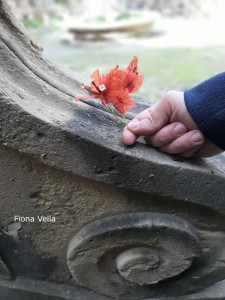 Some say that bad luck isn’t real and that there is no such thing as luck. Yet others would strongly avoid walking under a ladder or crossing the street in the presence of a black cat. They will certainly not open an umbrella indoors or drink any water that reflects moonlight, in the fear of attracting misfortune. Still, there are those who insist that whether you see it as lucky or unlucky, the chance event is the same. But is it?
Some say that bad luck isn’t real and that there is no such thing as luck. Yet others would strongly avoid walking under a ladder or crossing the street in the presence of a black cat. They will certainly not open an umbrella indoors or drink any water that reflects moonlight, in the fear of attracting misfortune. Still, there are those who insist that whether you see it as lucky or unlucky, the chance event is the same. But is it?John Hookham Frere, a British diplomat, poet, scholar and philanthropist, is not known to have spoken of bad luck. However, when years went by and he started to suffer the loss of his loved ones all during the same month, he lamented that January was becoming too melancholic for him.
Rumours say that his mother Jane, daughter of John Hookham (senior) who was a rich London merchant, had brought an astrologer’s silver cup as part of her marriage dowry. This cup originally belonged to her great uncle, John Dee, who was believed to be a conjurer. Legend said that he had used the cup to make some supernatural experiments but she insisted that this was not true. In defiance, she used the cup as a sugar bason.
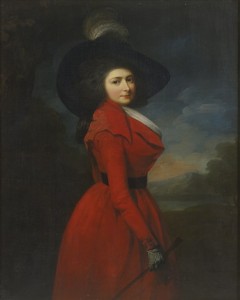 Curiously, the ‘January calamity’ had already struck the woman that Frere would eventually marry – Elizabeth Jemima Blake. A portrait painted by Sir Martin Shee shows her as a very beautiful girl with large dark eyes and masses of dark hair. In January 1790, she married George, sixteenth Earl of Erroll, who committed suicide in June 1798 after he confided an official secret to a friend who then published the communication and its author.
Curiously, the ‘January calamity’ had already struck the woman that Frere would eventually marry – Elizabeth Jemima Blake. A portrait painted by Sir Martin Shee shows her as a very beautiful girl with large dark eyes and masses of dark hair. In January 1790, she married George, sixteenth Earl of Erroll, who committed suicide in June 1798 after he confided an official secret to a friend who then published the communication and its author.The childless and beautiful widow met Frere in the year 1800 when she was recommended to stay in Lisbon to alleviate her mourning sorrows. At the time, Lisbon was a favourite health resort and Frere, who had just been appointed Envoy to the Court of Lisbon, was requested by a common friend to take care of her. Soon, the two became very good friends and along the years, they kept in contact through letters. Eventually, they got married on the 12th September 1816.
Lady Erroll never regained her health completely and this was a constant source of anxiety to her husband. A severe cold which she got while visiting the new rooms that were built at the British Museum for the Elgin marbles, wrought permanent damage to her constitution. A serious illness in 1820 obliged Frere to take her abroad and although she recovered some strength while travelling in the Mediterranean, it was clear that she would not survive the cold English climate.
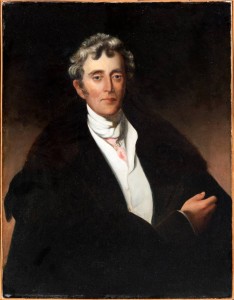 Since Frere preferred to live among English subjects, he chose to move to Malta. His sister Susanna, who had never married and who offered to help him to take care of his wife, joined them too. Initially, they resided in Casa Correa, a palatial building in Old Bakery Street, Valletta. Later on, they moved to Pietá, where they acquired two adjoined buildings, so that Susanna could live close by. This house on the waterfront helped Elizabeth to recover to better health and Frere began to show interest in the Maltese Islands which were so rich in history.
Since Frere preferred to live among English subjects, he chose to move to Malta. His sister Susanna, who had never married and who offered to help him to take care of his wife, joined them too. Initially, they resided in Casa Correa, a palatial building in Old Bakery Street, Valletta. Later on, they moved to Pietá, where they acquired two adjoined buildings, so that Susanna could live close by. This house on the waterfront helped Elizabeth to recover to better health and Frere began to show interest in the Maltese Islands which were so rich in history.Frere was very proficient in languages, namely Greek, Latin, Italian, French and Spanish. In Malta, he extended his knowledge in the Maltese and Hebraic languages. His ample library filled with prestigious and rare books became renowned with scholars, some of whom came to visit from abroad. At this time, he met Mikiel Anton Vassalli, a Maltese writer, linguist and philosopher.
Vassalli was expelled from Malta a number of times due to his political beliefs. His troubled life led to much difficulties and Frere helped to alleviate some of his problems. He financed the education of his three sons, supported him to publish his books and helped him to start teaching at the University of Malta as the first Professor of Maltese language. Frere’s remarkable kindness persisted even after Vassalli’s death, on 12th January 1829, when he took the responsibility of his burial in the then Protestant cemetery of the Msida Bastion, after the Catholic Church refused to do so due to his alliance with the Protestants.
Almost two years later, Frere had to return to these burial grounds again, this time to bury his wife when she passed away on 17th January 1831. His wife’s loss overwhelmed him with grief but he refused to return to England even though his relatives and friends advised him to do so. Eventually, he decided to acquire the steep hill behind his house in Pietá, turning the landscape into a set of lovely fertile terraces that were embellished with refined temples. From these peaceful gardens, he could look out at the cemetery where his beloved was resting.
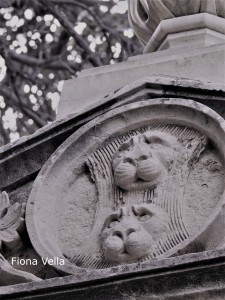 Yet the ominous month was set to claim another victim, this time his sister Susanna who died on the 18th January 1839, eight years and a day following the demise of his wife.
Yet the ominous month was set to claim another victim, this time his sister Susanna who died on the 18th January 1839, eight years and a day following the demise of his wife.In some letters which Frere wrote to his relatives and friends, he expressed his regret that the penalty of a long life was to see all those whom he had loved wither away and die. While his earlier years had been dedicated to political writing and literary satires, he passed the last years of his life composing epitaphs.
Instead of bringing an elation of joy at the beginning of a new year, January became acutely associated with death and Frere simply hated it. Who could have told him that this month would ultimately also claim his life – on 7th January 1846.
Currently, Heritage Malta holds the title for the iconic gardens of Villa Frere in Pietá. In February 2019, Heritage Malta and the NGO Friends of Villa Frere, signed a partnership and management agreement for the promotion, public availability, and the running and operation of the historical site.
The gardens of Villa Frere are opened for the public once a month or by appointment for groups. For further information, contact the NGO Friends of Villa Frere on Facebook or by email on villafrere@gmail.com
(This feature was published in the SENIOR TIMES – JANUARY issued with the Times of Malta dated 24 January 2020)
-
MALTA’S PREHISTORIC TREASURES
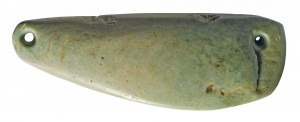 Who knows whose neck the exotic jadeite amulet adorned? To reach the Maltese shores, this item travelled a very long distance in prehistoric times. Therefore, it must have been really treasured, raising the status of its owner. It is difficult to see a symbolic meaning in such an amulet, however, it was chosen to accompany an individual who was laid to rest at the Xagħra Circle in Gozo.
Who knows whose neck the exotic jadeite amulet adorned? To reach the Maltese shores, this item travelled a very long distance in prehistoric times. Therefore, it must have been really treasured, raising the status of its owner. It is difficult to see a symbolic meaning in such an amulet, however, it was chosen to accompany an individual who was laid to rest at the Xagħra Circle in Gozo.We all know that person who would throw nothing away, and keeps mending an object till the very last. Well, it seems that such persons have existed since prehistoric times. A jar which was unearthed at Skorba Temples was drilled with pairs of holes above and below the crack to tie the two parts together with a long string. Who could tell whether these interventions served their purpose?
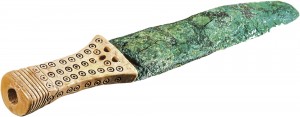 To whom did the elegant bone and copper dagger, that was discovered at Għar Mirdum in Dingli Cliffs, belong? Clearly designed for prestige rather than for defence, such a lovely object is unlikely to have been casually lost. So why was it left in this buried cave?
To whom did the elegant bone and copper dagger, that was discovered at Għar Mirdum in Dingli Cliffs, belong? Clearly designed for prestige rather than for defence, such a lovely object is unlikely to have been casually lost. So why was it left in this buried cave?Was the heavily pregnant female clay figure which was found at the Tarxien Temples, pierced in sixteen places with sharp fragments of shell, really intended to curse an opponent by magical means? And did the magic spell work?
While the first clay figure of the Sleeping Lady that was found in the Hypogeum of Ħal Saflieni rested on its side, another one discovered at the same site, lies face down with her breasts hidden beneath her. If either or both these figures could come to life, they would tell us a great deal about what we should dearly like to know about themselves and their times, though we might have great difficulty in understanding what they had to say. What would it take to wake them up?
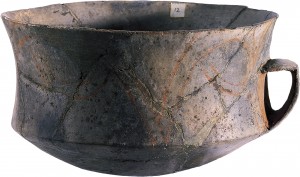 Archaeological discoveries are not only made in main sites. Nearby locations could be as significant for further revelations. The remains of a carinated clay offering bowl was recovered during investigations in the North Cave at the megalithic site of Ġgantija. Decorated with coloured scratched volutes, this bowl must have been considered sacred enough so as not to be casually scattered. It would be so intriguing to know in which rituals it was used.
Archaeological discoveries are not only made in main sites. Nearby locations could be as significant for further revelations. The remains of a carinated clay offering bowl was recovered during investigations in the North Cave at the megalithic site of Ġgantija. Decorated with coloured scratched volutes, this bowl must have been considered sacred enough so as not to be casually scattered. It would be so intriguing to know in which rituals it was used.These are only a few of the engaging narratives which form part of the collection of fifty artefacts in Heritage Malta’s latest publication “Malta’s Prehistoric Treasures”.
Skillfully chosen from the National Collection by the renowned late archaeologist Dr. David Trump, the artefacts are intended to accompany the readers along a personal journey in Maltese prehistory which fascinated him so much.
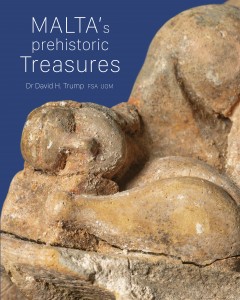 This makes the book even more significant since the selected artefacts are not only allowing the readers to learn about the local prehistoric people but also to see through the eyes of a very inspirational archaeologist.
This makes the book even more significant since the selected artefacts are not only allowing the readers to learn about the local prehistoric people but also to see through the eyes of a very inspirational archaeologist.The book has an additional narrative by Heritage Malta Senior Curator, Sharon Sultana.
Photography and design by Daniel Cilia.
Malta’s Prehistoric Treasures is available from Heritage Malta sites and museums.
For more information, visit www.heritagemalta.org
(This feature was published in The Times of Malta issued on 30th December 2019)
-
THE MAGIC IS IN THE DETAIL
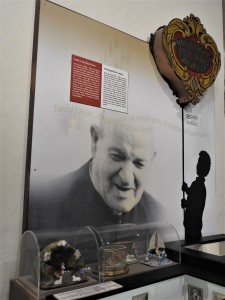 Although the main characters of the nativity scene are Joseph, Mary and baby Jesus, different cultures have added and altered the original representation in order to include their own characteristics. Some of these varying interpretations can be viewed in a permanent exhibition at the Inquisitor’s Palace in Birgu, which also houses the National Museum of Ethnography.
Although the main characters of the nativity scene are Joseph, Mary and baby Jesus, different cultures have added and altered the original representation in order to include their own characteristics. Some of these varying interpretations can be viewed in a permanent exhibition at the Inquisitor’s Palace in Birgu, which also houses the National Museum of Ethnography.In Malta, it was St George Preca (1880 – 1962) who fostered a lasting Christmas cult through his Society of Christian Doctrine. On Christmas Eve of 1921, he organized the first procession with a statue of baby Jesus. He also started the tradition of giving a crib and a statue of baby Jesus to every child who attended the MUSEUM centres.
In the exhibition, an image of Preca looks over at a rudimentary crib which has initiated a tradition that is still celebrated nowadays. A detailed diorama portrays further this tradition, showing a MUSEUM Superior handing out a crib to a boy, while a number of other children are already joyfully holding their cribs. An altar which is included in the diorama is decorated with flowing white vetch.
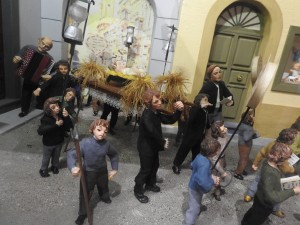 Another diorama looks like a time capsule showing the traditional procession of baby Jesus together with other local customs. Not only can one observe the MUSEUM members carrying the statue of baby Jesus, but one can also delight at the children carrying lights and Christmas messages while singing Christmas carols. The context is further enriched by the presence of traditional Maltese town houses, with their colourful wooden doors and with their wide open windows decorated with a small statue of baby Jesus.
Another diorama looks like a time capsule showing the traditional procession of baby Jesus together with other local customs. Not only can one observe the MUSEUM members carrying the statue of baby Jesus, but one can also delight at the children carrying lights and Christmas messages while singing Christmas carols. The context is further enriched by the presence of traditional Maltese town houses, with their colourful wooden doors and with their wide open windows decorated with a small statue of baby Jesus.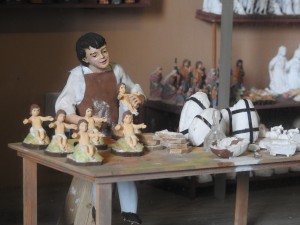 These two dioramas form part of a set that was donated to Heritage Malta by Austin Galea; a well-established artisan and personality among local crib enthusiasts, and a founding member of the Għaqda Ħbieb tal-Presepju (Malta). The set of dioramas give life to further Christmas traditions, such as the sermon of the altar boy during Christmas’ eve mass, a large crib displayed for public viewing, a group of craftsmen in a workshop manufacturing statues and cribs, and a Christmas lunch being enjoyed by a family.
These two dioramas form part of a set that was donated to Heritage Malta by Austin Galea; a well-established artisan and personality among local crib enthusiasts, and a founding member of the Għaqda Ħbieb tal-Presepju (Malta). The set of dioramas give life to further Christmas traditions, such as the sermon of the altar boy during Christmas’ eve mass, a large crib displayed for public viewing, a group of craftsmen in a workshop manufacturing statues and cribs, and a Christmas lunch being enjoyed by a family.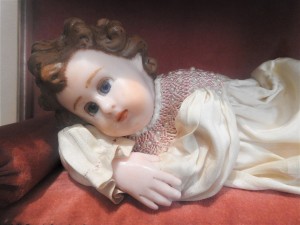 Galea has also donated two large nativity scenes which are typically exhibited in windows of private houses during the Christmas season in Malta. Other donations by him include different traditional statues of baby Jesus. Traditionally, the baby Jesus statues were made of wax to obtain a soft and translucent finish. The statues were eventually dressed up in an embroidered tunic, while many borrowed real hair from a toddler’s crowning curls.
Galea has also donated two large nativity scenes which are typically exhibited in windows of private houses during the Christmas season in Malta. Other donations by him include different traditional statues of baby Jesus. Traditionally, the baby Jesus statues were made of wax to obtain a soft and translucent finish. The statues were eventually dressed up in an embroidered tunic, while many borrowed real hair from a toddler’s crowning curls.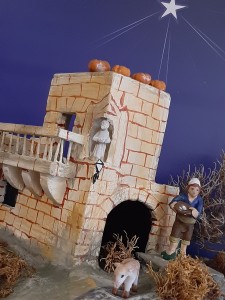 A large Maltese crib is also part of Galea’s generous donation. The crib is a comprehensive study of Maltese traditions in itself. Typical Maltese figurines are dressed in traditional local costumes, and among them, one also finds the unique Maltese symbolic characters. The Stupefied figurine represents those who are impressed by the profound meaning of the unique happening. The Beggar represents the poor who find consolation in Christ. The Climber represents those who find it difficult to understand the significance of Christ’s incarnation but strive to discover out. The Folk Singers represent communal association in praising the Lord, while the Sleeper represents those who ignore the immeasurable benevolence of Christ. The rugged landscape with its terraced fields, sparse vegetation, low-profile unpretentious farmhouses and a windmill are reminiscent of the rural ambience of the old times.
A large Maltese crib is also part of Galea’s generous donation. The crib is a comprehensive study of Maltese traditions in itself. Typical Maltese figurines are dressed in traditional local costumes, and among them, one also finds the unique Maltese symbolic characters. The Stupefied figurine represents those who are impressed by the profound meaning of the unique happening. The Beggar represents the poor who find consolation in Christ. The Climber represents those who find it difficult to understand the significance of Christ’s incarnation but strive to discover out. The Folk Singers represent communal association in praising the Lord, while the Sleeper represents those who ignore the immeasurable benevolence of Christ. The rugged landscape with its terraced fields, sparse vegetation, low-profile unpretentious farmhouses and a windmill are reminiscent of the rural ambience of the old times.Besides donating his first clay crib figurines which were given to him by his aunties and an unusual crib made of sacks that was constructed by him, Galea shares also his knowledge relating to Christmas crib construction in a short video which forms part of this exhibition.
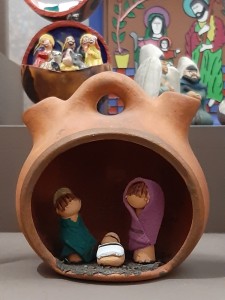 Another intriguing element in this exhibition is the donation of numerous miniature cribs which were brought by Albert and Lina McCarthy from all over the world. The professional tour managers have been gathering this impressive collection since the early 90s. Their collection amounts to more than 500 miniature works of art, a representative selection of which is on display at the Inquisitor’s Palace.
Another intriguing element in this exhibition is the donation of numerous miniature cribs which were brought by Albert and Lina McCarthy from all over the world. The professional tour managers have been gathering this impressive collection since the early 90s. Their collection amounts to more than 500 miniature works of art, a representative selection of which is on display at the Inquisitor’s Palace.Exhibited in four different sections, the varying nativity scenes representing North and East Europe, Southern Europe and the Near East, North and South America, and Africa, Asia, the Far East and Australia are simply enchanting. The magic is in the detail of each crib which presents the nativity scene in various contexts, with distinct characters and in diverse materials.
 Some of the most notable are the terracotta nativity sets from Hungary and Peru, the ceramic sets from Denmark and the Philippines, the engraved wooden shoe from Amsterdam, the wooden sets of Germany, Austria, Japan and Iran, the metallic artwork from Bali, the sack nativity set from Sri Lanka and the clay figurines of North Africa set in a bedouin tent, dressed in traditional costumes and accompanied by a camel instead of farm animals.
Some of the most notable are the terracotta nativity sets from Hungary and Peru, the ceramic sets from Denmark and the Philippines, the engraved wooden shoe from Amsterdam, the wooden sets of Germany, Austria, Japan and Iran, the metallic artwork from Bali, the sack nativity set from Sri Lanka and the clay figurines of North Africa set in a bedouin tent, dressed in traditional costumes and accompanied by a camel instead of farm animals.A visit to this permanent exhibition held at the Inquisitor’s Palace is most educational and entertaining for children, and also curious and insightful for adults. The exhibits are a tribute to local and foreign artisans who have used their creativity to reproduce the significant nativity scenes in various intriguing representations.
(Published in Christmas Times magazine issue with The Times of Malta dated 7th December 2019)
-
Bats at the museum
As the sun began to set, the sky darkened with the legion of bats which came out of the Rabat catacombs, noted G. Gulia in 1890 in his book Elenco dei Mammiferi Maltesi. Certainly, the tendency of these nightly creatures to live in such dreaded underground areas didn’t help them much in order not to be associated with evil and darkness. Likewise, their strange semblance, their mythical association with Dracula, and images of Satan bearing their wings, hindered even more their reputation. In Aztec and Mayan cultures, bats were deities connected to death. Yet nothing could be far from the truth since bats have a beneficial role in the earth’s ecosystem.
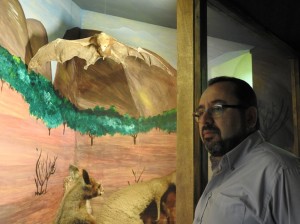 The importance of these unique flying mammals was highlighted during a recent activity which was organized by MEPA’s Environment Division in collaboration with Heritage Malta, at the National Museum of Natural History in Mdina. This annual event, recognized as Malta Bat Night, included a discussion about bats and listening to their sounds through an electronic device.
The importance of these unique flying mammals was highlighted during a recent activity which was organized by MEPA’s Environment Division in collaboration with Heritage Malta, at the National Museum of Natural History in Mdina. This annual event, recognized as Malta Bat Night, included a discussion about bats and listening to their sounds through an electronic device.“Malta Bat Night forms part of a partnership which we have with the European Union for the Research and Conservation of Bats,” explained John Joseph Borg, Senior Curator at the National Museum of Natural History.
“Such events are aimed to inform the public about bats in the hope of removing the negative impression that people have about them. Along the years, bats have decreased considerably in Malta, both because their habitat has often been disturbed, and also due to direct acts of vandalism which were carried out upon them.”
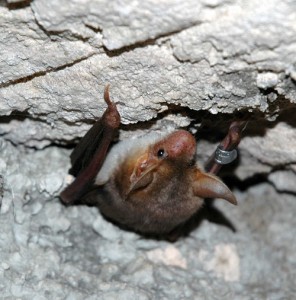 Indeed, Borg explained that colonies of bats have been repeatedly put on fire whilst they were resting in their caves. Others were smothered when vandals threw mud and other things at them, even though they were clearly being protected behind a gate, such as in the case of Ħasan Cave. Bats of a small colony which lived in a site that had access to a particular school, were burnt alive by school children after they captured them and drenched them in hot candle wax.
Indeed, Borg explained that colonies of bats have been repeatedly put on fire whilst they were resting in their caves. Others were smothered when vandals threw mud and other things at them, even though they were clearly being protected behind a gate, such as in the case of Ħasan Cave. Bats of a small colony which lived in a site that had access to a particular school, were burnt alive by school children after they captured them and drenched them in hot candle wax.Well, after hearing these stories, it becomes very clear who the evil ones are.
“Unfortunately our culture has taught us to fear and hate these creatures. In actual fact, their presence could be very advantageous to humans,” revealed Borg.
“Many of the bats eat insects and studies have shown that they tend to feed on species that are harmful to humans and to agriculture. Other small bats which have an elongated snout and a long tongue, act as pollinators when they enter into flower tubes to lick the pollen inside and then move onto different plants. Larger bats, which may look spooky and scary, nurture themselves on decaying fruit and therefore, they keep the fruit trees healthy.”
What about the so called vampire bats. Were they real? And do we have them in Malta?
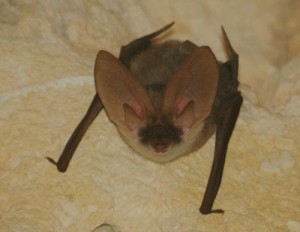 “In contrast to peoples’ impression that all bats can suck blood, most of them thrive on insects, fruit, fish and frogs. The only vampire bats which feed on blood are found in South America and they are pretty small. They are nothing similar to the fictional bats that we see in films. In fact, they do not suck blood but they lick it, thanks to their anticogulant saliva which prevents the blood from clotting. They do not normally attack human beings and neither animals. However, they will feed on any animal available if it is reachable to them, including humans.”
“In contrast to peoples’ impression that all bats can suck blood, most of them thrive on insects, fruit, fish and frogs. The only vampire bats which feed on blood are found in South America and they are pretty small. They are nothing similar to the fictional bats that we see in films. In fact, they do not suck blood but they lick it, thanks to their anticogulant saliva which prevents the blood from clotting. They do not normally attack human beings and neither animals. However, they will feed on any animal available if it is reachable to them, including humans.”Borg informed me that we have seven resident species of bats which are: Lesser Horse-shoe Bat (Rhinolophus hipposideros), Maghrebian Bat (Myotis punicus), Grey Long-eared Bat (Plecotus austriacus), Savi`s Pipistrelle (Hypsugo savii), Kuhl`s Pipistrelle (Pipistrellus kuhlii), Common Pipistrelle (Pipistrellus pipistrellus), and Soprano Pipistrelle (Pipistrellus pygmaeus).
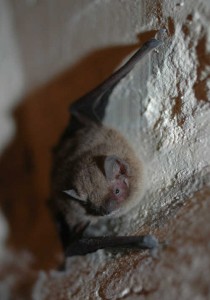 “We have bats from all these resident species living in this museum,” smiled Borg who has an avid passion about bats. “In the underground tunnels there are the Lesser Horse-shoe and the Maghrebian Bats, whereas in the rooms of the underlying level, one finds the Grey Long-eared and the Lesser Horse-shoe Bats. Moreover, all the four Pipistrelle species have managed to make a home in some cracks of the facade and on the high beams.”
“We have bats from all these resident species living in this museum,” smiled Borg who has an avid passion about bats. “In the underground tunnels there are the Lesser Horse-shoe and the Maghrebian Bats, whereas in the rooms of the underlying level, one finds the Grey Long-eared and the Lesser Horse-shoe Bats. Moreover, all the four Pipistrelle species have managed to make a home in some cracks of the facade and on the high beams.”From the remains of moth wings which Borg collects from the museum floor early in the morning for his studies, he is able to identify more information about his resident bats, such as what they prey on. Interestingly, each small Pipistrelle is able to eat around 20,000 moth each night, thereby being more effective than the insect sprays which we use. Nonetheless, most people have no idea about this and when they realize that they are co-habitating with bats, hell breaks lose.
“We do receive calls from people who request us to remove bats from their properties. It is very rare that these creatures enter into homes. Usually they live in cracks in external windows or in narrow openings in facades. Some of the bats are minute in size and in fact, five of them can be placed in a matchstick box. Generally, once these people realize that these animals will be doing no harm to them or to their family, they will agree to allow them to stay. Yet there were cases when the individuals concerned were adamant that they wanted them removed.”
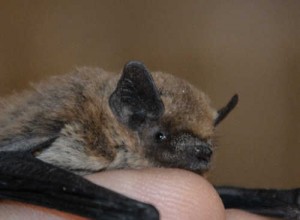 In such cases, Borg or other responsible officials will need to go and survey the bats before taking action. This involves counting them daily for a whole week in order to confirm the exact amount of bats that are roosting in this place. Once, this amount is identified, they will wait until all the bats are out at night and then they will block the nest in order not to let them in again. Eventually, when the bats will return home and realize what happenned, they will automatically move away to a second area which they tend to keep as a form of protection.
In such cases, Borg or other responsible officials will need to go and survey the bats before taking action. This involves counting them daily for a whole week in order to confirm the exact amount of bats that are roosting in this place. Once, this amount is identified, they will wait until all the bats are out at night and then they will block the nest in order not to let them in again. Eventually, when the bats will return home and realize what happenned, they will automatically move away to a second area which they tend to keep as a form of protection.“This procedure to count bats is very important because they do not always leave the nest in the same number. Usually, a scout bat will fly out first in order to check whether it is windy and whether there are enough insects available in the area. If he returns, the others will stay inside but if he does not, they will understand that the situation is favourable and they will fly out too.”
I couldn’t help feeling impressed by these creatures. Yet more was still to come.
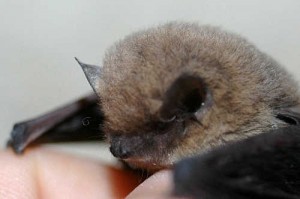 “The courting and copulation of bats takes place in autumn, between October and November. Then, as soon as the temperature drops and insects are more rare, they will fall in a state of torpidity which is a short period of sleep. During this time, the sperm with which the female has been fertilized will remain stored inside her, waiting for the right moment to come. Once the tempertaure gets warmer and insects become available, these bats will wake up and the real preganancy will start. In this way, both the mother and the offspring will have a better chance to survive.”
“The courting and copulation of bats takes place in autumn, between October and November. Then, as soon as the temperature drops and insects are more rare, they will fall in a state of torpidity which is a short period of sleep. During this time, the sperm with which the female has been fertilized will remain stored inside her, waiting for the right moment to come. Once the tempertaure gets warmer and insects become available, these bats will wake up and the real preganancy will start. In this way, both the mother and the offspring will have a better chance to survive.”Although there are some who associate bats with flying mice, Borg informed me that there is nothing common between the two. While mice come from the order Rodentia, bats form part of the order of Chiroptera (meaning hand-wing).
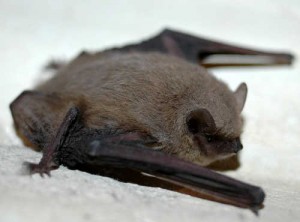 “The oldest bat fossils date back to 55 million years ago where this mammal had already the shape which we know today. On the other hand, the oldest fossils which were found in Malta go back to the Ice Age at around 200,000 and 10,000 years ago. These were found during excavations at Għar Dalam and so we can say that these ancient bats remember the dwarf elephants and hippopotami roaming around. At this museum, we do hold a sample of these fossils. However, the majority of them were taken by the foreign researchers who were doing the excavations, and these passed on their discoveries to their relative museums.”
“The oldest bat fossils date back to 55 million years ago where this mammal had already the shape which we know today. On the other hand, the oldest fossils which were found in Malta go back to the Ice Age at around 200,000 and 10,000 years ago. These were found during excavations at Għar Dalam and so we can say that these ancient bats remember the dwarf elephants and hippopotami roaming around. At this museum, we do hold a sample of these fossils. However, the majority of them were taken by the foreign researchers who were doing the excavations, and these passed on their discoveries to their relative museums.”In the Mdina museum, one can also find some current bat specimens. Borg insisted that it is not the policy of the museum to capture and kill creatures in order to preserve them. So, one won’t find a specimen for each species which live in Malta. Nevertheless, the museum will do his best to assist whoever will request information about bats.
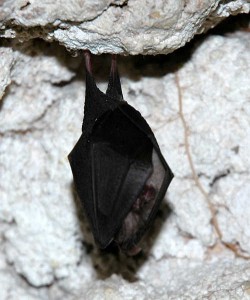 Borg’s own interest in bats goes back to the 1980s. Originally fearful of them, he came face to face with these bats whilst he was doing bird studies and these nightly creatures were being captured accidentally in nets. At first nervous, he asked others to remove them for him, until one day, he decided to do the job himself.
Borg’s own interest in bats goes back to the 1980s. Originally fearful of them, he came face to face with these bats whilst he was doing bird studies and these nightly creatures were being captured accidentally in nets. At first nervous, he asked others to remove them for him, until one day, he decided to do the job himself.From then on, he was completely captivated by them and has been studying them ever since, eager to share his knowledge in the hope of fostering more interest from the public.
It is safe to say that Malta Bat Night has certainly gone a long way towards achieving this.
(This article was published in Escape Suppliment issued with the Sunday Times of Malta dated 29th November 2015)
-
L-attakk fuq l-isperun tal-Isla
Għal dawk kollha li tinteressahom l-Istorja ta’ Malta, din is-sena hija waħda sinifikattiva ħafna, peress li qed jiġi kkommemorat l-450 anniversarju mill-Assedju l-Kbir li seħħ fil-gżejjer tagħna fl-1565. Diversi kotba, lekċers, blogs, u attivitajiet relatati ma’ din it-tema, qegħdin ikomplu jqanqlu l-entużjażmu sabiex wieħed isir jaf aktar dwar din il-battalja qalila, fosthom għaliex seħħet, kif żvolġiet, min ħa sehem, x’kienu l-istrateġiji użati, u kif finalment il-Kavallieri ta’ San Ġwann u l-Maltin ħarġu rebbieħa akkost id-diffikultajiet kollha.
Sabiex jirrakkuntaw dawn il-fatti, nibtu wkoll numru ta’ paġni fuq Facebook u permezz tagħhom, wieħed jista’ jara biċ-ċar li mhumiex il-Maltin biss li qed jinvolvu ruħhom f’din il-kommemorazzjoni, imma anki għadd ta’ individwi minn madwar id-dinja kollha. B’hekk, din il-ġrajja tal-Assedju, qed isservi wkoll biex tiġbed l-attenzjoni tal-barranin lejn il-gżejjer tagħna u possibilment, uħud minnhom jafu jitħajjru jżuruna.
Mudell li juri l-attakk fuq l-isperun tal-Isla
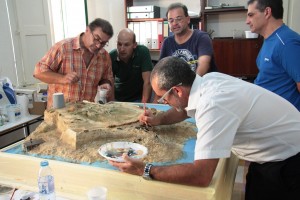 Waħda minn dawn il-paġni tal-Facebook hija ‘The assault on the Spur, Isla, 15th July 1565’ li permezz ta’ bosta ritratti, qed turi u tispjega pass pass, it-tnissil u l-kostruzzjoni ta’ diorama, jew mudell, tal-isperun tal-Isla. Għall-ewwel, segwejt dan il-grupp permezz tar-ritratti li kien qed itella’. Iżda eventwalment, tant sibt ix-xogħol li kien qed jitwettaq intriganti, li deherli li kien jixraq li mmur nagħtih titwila ħalli narah b’għajnejja.
Waħda minn dawn il-paġni tal-Facebook hija ‘The assault on the Spur, Isla, 15th July 1565’ li permezz ta’ bosta ritratti, qed turi u tispjega pass pass, it-tnissil u l-kostruzzjoni ta’ diorama, jew mudell, tal-isperun tal-Isla. Għall-ewwel, segwejt dan il-grupp permezz tar-ritratti li kien qed itella’. Iżda eventwalment, tant sibt ix-xogħol li kien qed jitwettaq intriganti, li deherli li kien jixraq li mmur nagħtih titwila ħalli narah b’għajnejja.“Huma ħafna dawk li qed juru x-xewqa li jiġu jaraw dan il-mudell,” stqarr Alex Schembri, President ta’ Society for Scale Modellers – IPMS Malta. “Napprezzaw ferm li l-pubbliku qiegħed isegwi x-xogħol tagħna b’tant ħeġġa u qed nagħmlu minn kollox biex sal-15 ta’ Lulju, inkunu nistgħu nvarawh ftit billi nippreżentaw diversi ritratti tiegħu.”
Society for Scale Modellers – IPMS Malta
Society for Scale Modellers ġiet imwaqqfa f’Jannar tal-1981. L-għan prinċipali ta’ dan il-klabb dejjem kien li jgħolli l-livell tal-iscale modelling f’pajjiżna sabiex jikkompara ma’ dak internazzjonali. Infatti l-klabb huwa affiljat mal-International Plastic Modellers Society li għandha rappreżentanti tagħha f’diversi pajjiżi madwar id-dinja.
L-iscale modelling jieħdok sa fejn trid
“Għalkemm dan il-qasam ġeneralment jitqies bħala passatemp, aħna xorta waħda nagħtuh attenzjoni kbira billi naraw li x-xogħol isir bi professjonalità. Imma fir-realtà, l-iscale modelling jieħdok sa fejn trid u infatti fost il-membri, għandna numru minnhom li huma esperti tassew, tant li rebħu diversi kompetizzjonijiet barra minn Malta. Oħrajn saru jipproduċu l-prodotti tagħhom u jbiegħuhom.”
Kull sena, din is-Soċjetà ttella’ esebizzjoni bix-xogħolijiet li jkunu saru mill-membri tagħha u f’dak iż-żmien, ikun hemm numru ta’ nies li jitħajjru jingħaqdu magħha.
“Idealment l-età tal-membri tagħna tibda minn 17 il-sena sabiex wieħed jilħaq jitrawwem f’dan il-qasam. Niltaqgħu darba f’ġimgħa ħalli nuru x-xogħolijiet li qed nagħmlu u flimkien niddiskutu x’jista’ jsir aħjar. Hawnhekk kulħadd ikollu l-preferenzi tiegħu: min jaħdem il-mudelli tal-ajruplani, min il-figuri, min il-karozzi, oħrajn inġenji tal-baħar eċċ. U għalhekk, wieħed jgħin u jgħallem lill-ieħor sabiex il-mudell tiegħu ikun aktar perfett u komplet.”
Proġett li ġabar flimkien lill-membri kollha
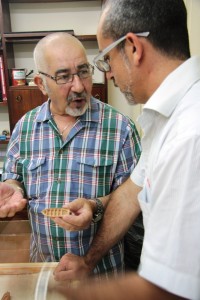 Fil-fatt, matul dawn l-aħħar xahrejn, prattikament il-membri kollha qegħdin jagħtu daqqa t’id biex jissawwar dan il-mudell imdaqqas tal-isperun tal-Isla.
Fil-fatt, matul dawn l-aħħar xahrejn, prattikament il-membri kollha qegħdin jagħtu daqqa t’id biex jissawwar dan il-mudell imdaqqas tal-isperun tal-Isla.L-għażla ta’ din it-tema oriġinat minn Ivan Cocker, wieħed mill-membri.
“Dehrilna li peress li dis-sena qed nikkommemoraw l-450 anniversarju mill-Assedju l-Kbir, kien jixraq li niddedikaw xi biċċa xogħol għalih. Wara li ddiskutejt din l-idea ma’ sħabi u mal-Kuraturi ta’ Heritage Malta, Emmanuel Magro Conti u Liam Gauci, l-għażla tagħna waqgħet fuq l-isperun tal-Isla minħabba li fuq dan il-Post ta’ Don Francisco de Sanoguera kien hemm il-konċentrament tal-attakk u anki peress li dan il-lwog kien l-uniku wieħed waqt dan l-assedju li ġiet attakkat kemm mill-art u kif ukoll mill-baħar,” spjegali Ivan.
Ir-riċerka nvoluta biex isir dan il-mudell
Hekk kif intagħżel il-lwog li kienu se joħolqu l-mudell tiegħu, bdiet riċerka sfieqa ħalli tinkiseb kemm jista’ jkun informazzjoni, l-aktar minħabba li llum ftit li xejn fadal minn dan l-isperun.
“Irreferejna ma’ għadd ta’ kotba, mapep, mużewijiet, u pitturi sabiex inkunu nistgħu noħolqu mudell kemm jista’ jkun viċin għal dak li kien jeżisti tassew f’dak il-perjodu. Ngħidu aħna biex bdejna nibnu l-isperun, imxejna mal-ktieb ta’ Balbi, li kien suldat li ħa sehem f’dan l-assedju. Rajna wkoll pjanti ta’ llum tal-Isla peress li sirna nafu li l-pedament tal-isperun għadu hemm. Fittixna wkoll kotba tal-istorja u tal-fortifikazzjonijiet li jsegwu dak li seħħ wara l-assedju ħalli b’hekk nagħrfu x’kienu dawk ix-xogħolijiet li saru wara, kemm mill-Kavallieri nfushom u kif ukoll mill-Imperu Ingliż.”
Mudell maħdum fuq skala 1:72
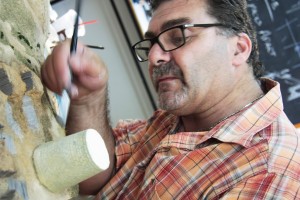 Huma użaw ukoll il-pjanti biex jiffurmaw l-iskala tal-mudell 1:72 ħalli b’hekk janalizzaw ukoll sa fejn se jkopri.
Huma użaw ukoll il-pjanti biex jiffurmaw l-iskala tal-mudell 1:72 ħalli b’hekk janalizzaw ukoll sa fejn se jkopri.“Ma stajnix nagħmlu l-Isla kollha, naturalment. Għalhekk iffukajna fuq l-isperun, u permezz tal-pjanti, ħriġna bl-iskala. Ħdimna b’reqqa kbira imma mbagħad kien hemm mument fejn kellna nagħlqu għajnejna. Dan seħħ per eżempju fil-każ tal-mitħna li fir-realtà kienet tinsab aktar lura minn fejn tidher fil-mudell. Madanakollu, peress li l-imtieħen lagħbu parti importanti f’din il-battalja, anki peress li biswiethom, l-Ordni kellha l-kanuni, ma kienx jagħmel sens li nħalluha barra,” infurmani Oliver Mifsud hekk kif beda jurini kif qed jinħadem dan il-mudell.
Sabiex il-mudell ma jkunx tqil wisq, il-pedamenti tiegħu tfasslu mill-ġablo u mbagħad fuqu beda l-kisi ta’ materjal ieħor ħalli jiġu ffurmati l-art u l-fortifikazzjoni. Imbagħad, biex il-lewn ta’ dawn jiġi jixbaħ lill-ġebla tal-franka Maltija, ġie xkatlat il-ġebel fil-wiċċ, mgħejjun ukoll miż-żebgħa ħalli joqrob aktar lejn ir-realtà.
Kull parti tal-mudell għandha l-istorja tagħha
Dawwruni ftit mal-mudell biex inkun nista’ nifli d-dettalji li fih. Intbaħt li skont minn fejn tħares lejn dan il-mudell, tkun tista’ ssegwi parti mill-ġrajja ta’ dak li seħħ f’dan il-post waqt l-assedju.
“Biex inkunu aktar preċiżi, segwejna wkoll mill-qrib kif saru l-attakki fuq dan l-isperun, ħalli b’hekk nagħrfu aħjar fejn saru l-ħsarat u t-tifrik, fejn tpoġġa ċertu lqugħ għad-difiża, fejn kien hemm il-katina biex iżżomm ix-xwieni tal-għadu milli jidħlu, u fejn il-Gran Mastru Jean de la Valette ordna biex isir l-ostaklu ġol-baħar li kellu jtellef lit-Torok milli jersqu bid-dgħajjes tagħhom,” qalli Ivan.
Minkejja t-tiftix u r-riċerka, xorta jibqgħu numru ta’ mistoqsijiet dwar uħud minn dawn li semmejt peress li issa għadda ħafna żmien u wieħed ikollu joqgħod biss fuq dak li jirnexxielu jsib.
Skoperti fatti kurjużi waqt il-ħidma ta’ dan il-mudell
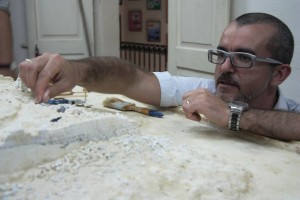 “L-ostaklu fil-baħar huwa eżempju minnhom,” fissirli Ivan. “Biex fassalnih, qgħadna ħafna fuq id-dettalji ta’ Balbi. Imma aħna u naħdmuh, ma stajniex nifhmu l-għala dan l-ostaklu ma sarx biex ikopri t-tul kollu tal-art imma tħalliet parti mikxufa minn fejn wieħed seta’ jidħol.”
“L-ostaklu fil-baħar huwa eżempju minnhom,” fissirli Ivan. “Biex fassalnih, qgħadna ħafna fuq id-dettalji ta’ Balbi. Imma aħna u naħdmuh, ma stajniex nifhmu l-għala dan l-ostaklu ma sarx biex ikopri t-tul kollu tal-art imma tħalliet parti mikxufa minn fejn wieħed seta’ jidħol.”“Intant, meta bqajna niflu dan id-dettall, sibna li fejn inbena l-ostaklu, il-baħar kien aktar baxx, filwaqt li fil-parti l-miftuħa, il-baħar kien fond. Għalhekk, komplejna deħlin nistħarrġu l-istorja u ma domnix ma skoprejna li għall-attakk tal-15 ta’ Lulju 1565 fuq dan l-isperun tal-Isla, il-Kmandanti Ottomani kienu bagħtu suldati li ma jafux jgħumu ħalli b’hekk ma jkunux jistgħu jirtiraw billi jgħumu lura.”
Uħud mill-membri li nġabru ħdejna ammettew illi qabel bdew jaħdmu fuq dan il-mudell, ftit li xejn kienu jafu dwar din il-parti tal-istorja ta’ Malta. Imma issa kien xort’oħra hekk kif bdew jinteressaw ruħhom dejjem aktar u l-għatx għall-informazzjoni kull ma jmur dejjem jikber.
Parti mill-mudell tal-mitħna maħdum minn disinjatur industrijali Amerikan
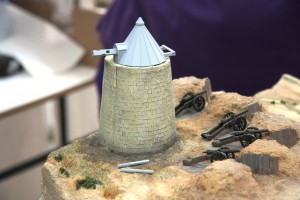 Biċċa xogħol oħra li qanqlet riċerka kienet il-mitħna.
Biċċa xogħol oħra li qanqlet riċerka kienet il-mitħna.“Ma stajniex noqogħdu biss fuq l-affreski ta’ D’Aleccio peress li fix-xogħolijiet tiegħu, dawn l-imtieħen ivarjaw. Jidher ċar li f’dan il-każ, l-artist uża l-immaġinazzjoni tiegħu u għalhekk aħna ridna nsibu x-xbieha reali tagħhom,” fissirli Alex.
“Inxtħetna nirriċerkaw dan is-suġġett u sibna li l-imtieħen tar-riħ ma kienux inbidlu wisq matul is-snin. Dorna anki diversi eżempji ta’ mtieħen li jinsabu hawn Malta u kif ukoll f’xi pajjiżi tal-Mediterran, sakemm finalment, ħriġna b’disinn li jqarreb kemm jista’ lejn l-oriġinal.”
Fatt li ta’ min isemmi huwa illi meta dan il-grupp wasal biex jaħdem din il-mitħna, il-parti ta’ fuq, li hija l-aktar diffikultuża, spiċċat saret minn sors li ma kienux qed jistennew.
“Kif taf inti, huma ħafna dawk li qed isegwu x-xogħol tagħna permezz tal-Facebook. Fosthom hemm Pete Hamann, disinjatur industrijali Amerikan, li tant apprezza dan il-proġett, li offra li jagħtina daqqa t’id. Hekk kif ġietna x-xoqqa f’moxtha, issuġġerejna li jaħdmilna l-parti ta’ fuq ta’ din il-mitħna li kienet tinsab fuq l-għolja tal-Isla u fi ftit taż-żmien, hu pprovdina bil-mudell 3D li ħadem apposta għalina.”
Numru kbir ta’ figuri jagħtu l-ħajja lill-mudell
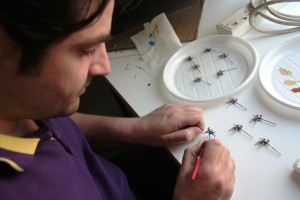 Dettall ieħor li jien apprezzajt ferm kien in-numru kbir ta’ figuri li kienu qed ikomplu jagħtu l-ħajja lil dan il-mudell. Skoprejt li kien hemm madwar 400 figura mqassma bejn Kavallieri u Ottomani.
Dettall ieħor li jien apprezzajt ferm kien in-numru kbir ta’ figuri li kienu qed ikomplu jagħtu l-ħajja lil dan il-mudell. Skoprejt li kien hemm madwar 400 figura mqassma bejn Kavallieri u Ottomani.“Dawk xtrajnihom bħala kits u issa qed niżbugħhom skont il-perjodu,” urini Alex hekk kif tani f’idejja numru minnhom.
Id-dettall li kien fihom kien straordinarju u bla dubju maħdum b’ħila u b’paċenzja kbira.
Mudell li jgħinek tara l-Istorja b’għajnejk
Bħala waħda minn dawk li qed insegwi ġurnata b’ġurnata l-ġrajja tal-Assedju l-Kbir, nistqarr li apprezzajt ferm il-possibilità li nara b’għajnejja dan il-mudell u nifli d-dettalji li fih, hekk kif permezz tiegħu, stajt nifhem aħjar dak li kont qed naqra dwaru.
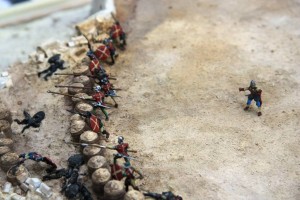 “Meta jitlesta dan il-mudell, nixtiequ ħafna nagħtuh bħala donazzjoni lil Heritage Malta sabiex b’hekk huwa jkun jista’ jservi bħala għodda edukattiva kemm għall-istudenti u kif ukoll għall-pubbliku li jżuru. Qed nittamaw li forsi dan il-mudell ikun jista’ jiġi nvolut ukoll fl-esebizzjoni internazzjonali li Heritage Malta se tkun qed torganizza fil-Palazz tal-Gran Mastru l-Belt bejn l-4 ta’ Settembru u s-6 ta’ Diċembru 2015.”
“Meta jitlesta dan il-mudell, nixtiequ ħafna nagħtuh bħala donazzjoni lil Heritage Malta sabiex b’hekk huwa jkun jista’ jservi bħala għodda edukattiva kemm għall-istudenti u kif ukoll għall-pubbliku li jżuru. Qed nittamaw li forsi dan il-mudell ikun jista’ jiġi nvolut ukoll fl-esebizzjoni internazzjonali li Heritage Malta se tkun qed torganizza fil-Palazz tal-Gran Mastru l-Belt bejn l-4 ta’ Settembru u s-6 ta’ Diċembru 2015.”Infatti mill-ġimgħa d-dieħla, fil-blog tal-Assedju l-Kbir ta’ Heritage Malta, www.heritagemalta.org/1565, wieħed se jkun jista’ jibda jiskopri uħud mill-oġġetti li se jkunu qed jiġu esebiti f’din l-esebizzjoni, li hi maħsuba li se tkun waħda mill-avvenimenti l-aktar importanti ta’ din is-sena relatati mal-ġrajja tal-Assedju tal-1565.
Aktar tagħrif dwar Society for Scale Modellers – IPMS Malta jista’ jinkiseb minn SSM House, Sulphur Lane, Ħamrun, inkella permezz tas-sit www.ipmsmalta.com u l-email info@ipmsmalta.com, jew permezz tal-Facebook.
(Dan l-artiklu ġie ppubblikat fis-sensiela MINN RITRATT (17 il-Parti) fit-Torċa tat-12 ta’ Lulju 2015)
-
Djarju ta’ poeta, suldat fl-Assedju l-Kbir
450 sena ilu, Malta kienet għaddejjha minn wieħed mill-agħar perjodi fl-istorja tagħha, hekk kif din ġiet attakkata minn armata kbira Torka li kienet ħalfet li se teqred lill-Ordni tal-Kavallieri ta’ San Ġwann minn wiċċ id-dinja. It-Torok ma kellhom l-ebda dubju li dil-gżira ċkejkna kienet ser tiġi f’idejhom f’qasir żmien u waqt bosta mumenti, anki l-kavallieri għaddielhom minn moħħhom l-istess ħsieb. Imma wara assedju kbir li ħalla warajh mijiet ta’ mejtin u midruba, fosthom lill-magħruf Dragut, Malta, il-Maltin u l-kavallieri, irnexxielhom joħorġu rebbieħa u t-Torok ġew f’sitwazzjoni fejn kellhom jirtiraw b’mod immedjat.
Affreski li juru xeni mill-assedju tal-1565
Fatt interessanti huwa illi l-aktar episodji sinifikanti li seħħu waqt dan l-assedju ġew impinġija mill-artist Taljan, Matteo Perez d’Aleccio. Huwa ġie kkummissjonat jagħmel dax-xogħol minn Fra Jean l’Evesque de La Cassiere, li kien il-Gran Mastru ta’ Malta bejn is-snin 1572 u l-1581. Is-sett ta’ affreski tal-Assedju l-Kbir tal-1565 kellu l-għan li jikkommemora dawn il-ġrajjiet tremendi imma erojċi li kienu ġraw xi ftit tas-snin qabel. M’hemmx xi ngħidu, rebħa monumentali bħal dik li kisbu l-kavallieri f’pajjiżna, kienet ġibdet ir-rispett u l-ammirazzjoni ta’ bosta pajjiżi, tant li l-Ordni mhux talli reġgħet ġiet fuq saqajha imma saret akbar milli qatt kienet qabel. Illum dawn l-affreski jinsabu ġewwa waħda mis-swali tal-Palazz tal-Gran Mastru fil-Belt Valletta u huma xhieda ta’ dak li għadda minnu pajjiżna fis-sena 1565.
It-taqtiegħa bejn l-Ordni u t-Torok
 Għal mijiet ta’ snin, il-Kavallieri ta’ San Ġwann u l-Ottomani kienu mqabbdin f’xulxin kemm fuq kwistjoni ta’ reliġjon u anki minħabba l-għatx li kellhom għall-poter sabiex jakkwistaw l-artijiet.
Għal mijiet ta’ snin, il-Kavallieri ta’ San Ġwann u l-Ottomani kienu mqabbdin f’xulxin kemm fuq kwistjoni ta’ reliġjon u anki minħabba l-għatx li kellhom għall-poter sabiex jakkwistaw l-artijiet.Għalkemm oriġinarjament, l-Ordni kellha l-funzjoni li tilqa’ u tieħu ħsieb il-pellegrini li kienu jaslu f’Ġerusalemm, maż-żmien din evolviet natura militari sabiex tiddefendi b’mod attiv il-pellegrini u r-reliġjon Kristjana. Naturalment, dan l-aġir tal-kavallieri, ma damx ma daħħalhom f’taqtiegħat mal-Musulmani, u aktar ma għaddew is-snin, dan il-ġlied beda jiżdied fil-feroċità tiegħu.
Hekk kif l-Ordni bdiet tikseb is-simpatija tan-nobbli, tar-rejiet u tal-Papiet, din bdiet tiġbed lejha wkoll bosta donazzjonijiet ta’ flus, rikkezzi, artijiet u privileġġi. B’hekk beda jikber ukoll il-poter tal-membri tagħha u dan wassal biex attira diversi tfal tan-nobbli li bdew jieħdu l-voti sabiex isiru kavallieri.
L-Ordni ta’ San Ġwann f’Rodi
L-Ordni tal-Kavallieri ta’ San Ġwann damet f’Ġerusalemm sal-1187, sakemm finalment, din il-belt waqgħet taħt il-kmand tas-Sultan Saladin. B’hekk il-kavallieri kellhom jibdlu l-kwartieri tagħhom u jimxu lejn Margat fis-Sirja, imbagħad f’Acre fi Tripli u eventwalment f’Limassol f’Ċipru. Madanakollu, x-xewqa tal-kavallieri kienet li jirnexxielhom jakkwistaw il-gżira ta’ Rodi, u fl-1309, huma rebħuha mingħand il-Biżantini.
Il-kavallieri ma damux ma għarfu u sarrfu l-kwalitajiet ta’ Rodi li kienet gżira b’pożizzjoni tassew strateġika hekk kif din kienet tgħaqqad id-dinja tal-Lvant ma’ dik tal-Punent. Huma bidlu lil din il-lokalità f’belt iffortifikata u maż-żmien, bnew flotta liema bħalha li bdiet tattakka b’mod regolari x-xwieni tal-Ottomani. Iżda dan ma kienx biżżejjed għall-kilba tal-poter u l-flus għax apparti x-xwieni, l-Ordni bdiet taħbat ukoll għal xi bliet u kastelli Ottomani, sakemm finalment, it-Torok ġew urtati mhux ħażin.
Il-kavallieri kienu saru xewka tweġġa’ ħafna qalb l-imperu Ottoman u t-Torok ma tħallew bl-ebda għażla ħlief li jaraw kif se jsibulhom tarfhom. Huma attakkaw lil Rodi għal diversi drabi imma qatt ma rnexxielhom iġibuha żewġ. Sakemm finalment, fl-1522, Sultan Suleiman ħa r-riedni f’idejh u ma qgħadx bi kwietu qabel niżżel il-kavallieri għarkubbtejhom wara sitt xhur ta’ kumbattimenti. Fuq deċiżjoni tal-istess sultan, l-Ordni tħalliet titlaq minn Rodi b’mod ċivili u dakinhar anki numru ta’ nies minn Rodi ngħataw il-libertà li jsegwuhom. Ftit kien jaf Suleiman, kemm xi snin wara, huwa kien ser jiddispjaċih bil-kbir talli wera tant irġulija mal-kavallieri.
Il-Kavallieri jsibu ruħhom Malta
Infatti, wara li l-kavallieri għamlu sebgħa snin iterrqu u jsalpaw minn art għall-oħra, mingħajr l-ebda post li setgħu isejjħulha darhom, huma ġew mogħtija l-gżejjer tagħna mill-Imperatur Charles V. Kien l-14 t’Ottubru 1530 meta huma middew l-ewwel passi tagħhom fuq l-art li eventwalment kellha tifforma parti tant importanti mill-istorja tal-Ordni.
Anki Malta nzertat li kellha pożizzjoni ġeografika sinifikattiva ħafna bħal dik ta’ Rodi, hekk kif din kienet tinsab f’nofs il-Mediterran bejn l-Ewropa u l-Afrika. Naturalment, il-kavallieri ma damux ma bnew fuq dan il-potenzjal sabiex jibdlu lil Malta f’fortizza. Filwaqt li n-nobbli ta’ Malta kienu jgħixu fl-Imdina, il-kavallieri ppreferew jistabilixxu ruħhom il-Birgu, l-aktar minħabba l-viċinanza tal-baħar. Dak iż-żmien, il-Birgu kien jikkonsisti biss f’raħal ċkejken tas-sajjieda li kellu kastell antik. Imma l-paġna ta’ dan il-post ma damitx ma nqalbet ta’ taħt fuq meta l-kavallieri bdew jibnu l-palazzi tagħhom u l-parroċċa tal-Birgu nbidlet fil-Knisja Konventwali tal-Ordni.
It-Torok jaħilfu li jeqirdu l-Ordni darba għal dejjem
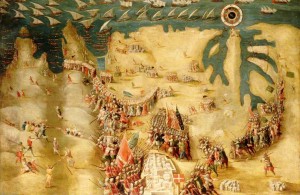 Fi ftit tas-snin, l-Ordni reġgħet issaħħet u l-qawwa tal-flotta tagħha bdiet tintuża biex mill-ġdid tattakka x-xwieni tal-Ottomani li kienu jsalpaw fl-ibħra tal-qrib. Il-ġarra ġejja u sejra fl-aħħar tinkiser u l-istorja rrepetiet ruħha, hekk kif mill-ġdid, it-Torok daħħluha f’rashom li jrażżnu lill-Ordni – issa, darba għal dejjem.
Fi ftit tas-snin, l-Ordni reġgħet issaħħet u l-qawwa tal-flotta tagħha bdiet tintuża biex mill-ġdid tattakka x-xwieni tal-Ottomani li kienu jsalpaw fl-ibħra tal-qrib. Il-ġarra ġejja u sejra fl-aħħar tinkiser u l-istorja rrepetiet ruħha, hekk kif mill-ġdid, it-Torok daħħluha f’rashom li jrażżnu lill-Ordni – issa, darba għal dejjem.Il-kavallieri kienu ilhom jisimgħu mingħand l-ispiji tagħhom li l-Ottomani kienu qed jippjanaw attakk kbir għal fuq Malta u min-naħa tagħhom, huma bdew jippruvaw jagħmlu dak kollu li jistgħu biex jippreparaw il-gżira sabiex tilqa’ għal dan l-assedju. Madanakollu, hekk kif il-kavallieri sabu l-flotta massiċċa tat-Torok ma’ wiċċhom fl-għodwa tat-18 ta’ Mejju tal-1565, huma baqgħu bla kliem.
Poeta jikteb djarju waqt li qed jieħu sehem fl-assedju
Minn hemm bdew il-battalji ħorox bejn il-kavallieri u l-Ottomani li damu għaddejjin sa erbgħa xhur wara. Fatt kurjuż huwa illi fost is-suldati li kienu qed jipparteċipaw f’dan l-assedju flimkien mal-Ordni, kien hemm ukoll min niżżel xi noti dwar dak li kien qed iseħħ.
Fost dawn, kien hemm Francesco Balbi di Correggio, poeta li kien jikteb bit-Taljan u bl-Ispanjol. Waqt l-assedju, huwa kellu 60 sena, u kien għażel li jservi bħala suldat minħabba li kien qed jgħix f’povertà kbira. Ta’ kittieb li kien, waqt dawn it-taqtiegħat storiċi, huwa żamm djarju fejn kważi ġurnata b’ġurnata jirrakkonta d-dettalji ta’ dak li għaddew minnu hu, sħabu u l-bqija tal-kavallieri, l-Maltin u t-Torok. Meta l-assedju spiċċa, huwa ra kif għamel biex ippubblika d-djarju tiegħu u llum xogħolu huwa meqjus bħala wirt storiku importanti ferm.
Bis-saħħa ta’ Balbi, illum, wara 450 sena, aħna nistgħu nsegwu pass pass kif żvolġa dan l-avveniment, kif ittieħdu d-deċiżjonijiet, l-iżbalji u l-istrateġiji effettivi li seħħu u diversi esperjenzi oħra.
Blog ta’ Heritage Malta dwar l-Assedju l-Kbir
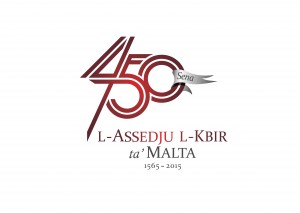 Sabiex taqsam dawn il-ġrajjiet interessanti mal-pubbliku, hekk kif dis-sena qed jiġi kkommemorat l-450 anniversarju mill-Assedju l-Kbir, Heritage Malta organizzat blog elettroniku fejn wieħed jista’ jaqra silta kuljum tal-aħbarijiet li jkunu ġraw f’dik il-ġurnata partikolari. F’dan il-blog, ma jonqsux ukoll xi fatti mhux tas-soltu u oħrajn kemmxejn kurjużi. Fl-istess blog, il-pubbliku se jkun jista’ jiskopri wkoll informazzjoni dwar numru ta’ oġġetti relatati mal-Assedju l-Kbir li bejn l-4 ta’ Settembru u s-6 ta’ Diċembru 2015, se jkunu qed jiffurmaw parti minn esebizzjoni internazzjonali li se tittella’ minn Heritage Malta fil-Kmamar Statali tal-Palazz tal-Gran Mastru l-Belt. Barra minn hekk, il-qarrejja ta’ dan il-blog se jkunu wkoll infurmati dwar id-diversi attivitajiet oħra relatati ma’ dan il-perjodu storiku li ser ikun qed jittellgħu minn żmien għall-ieħor.
Sabiex taqsam dawn il-ġrajjiet interessanti mal-pubbliku, hekk kif dis-sena qed jiġi kkommemorat l-450 anniversarju mill-Assedju l-Kbir, Heritage Malta organizzat blog elettroniku fejn wieħed jista’ jaqra silta kuljum tal-aħbarijiet li jkunu ġraw f’dik il-ġurnata partikolari. F’dan il-blog, ma jonqsux ukoll xi fatti mhux tas-soltu u oħrajn kemmxejn kurjużi. Fl-istess blog, il-pubbliku se jkun jista’ jiskopri wkoll informazzjoni dwar numru ta’ oġġetti relatati mal-Assedju l-Kbir li bejn l-4 ta’ Settembru u s-6 ta’ Diċembru 2015, se jkunu qed jiffurmaw parti minn esebizzjoni internazzjonali li se tittella’ minn Heritage Malta fil-Kmamar Statali tal-Palazz tal-Gran Mastru l-Belt. Barra minn hekk, il-qarrejja ta’ dan il-blog se jkunu wkoll infurmati dwar id-diversi attivitajiet oħra relatati ma’ dan il-perjodu storiku li ser ikun qed jittellgħu minn żmien għall-ieħor.Waħda min dawn l-attivitajiet li ġġib l-isem 1565:First and Last Hope se tiġi organizzata fil-Forti Sant’Iermu bejn is-26 u t-28 ta’ Ġunju 2015. Hawnhekk, diversi atturi popolari Maltin ser ikunu qed jagħtu l-ħajja mill-ġdid lil uħud mill-avvenimenti li seħħu waqt l-assedju, filwaqt li jinvolvu anki lill-pubbliku preżenti.
Il-blog tal-assedju qiegħed jinkludi wkoll xi filmati relatati ma’ dan iż-żmien. Intant, bħalissa, wieħed jista’ jsegwi filmat qasir li jirrakkonta d-destin kiefer tal-Kappella ta’ Sant’Anna li tinsab fil-Forti Sant’Iermu.
Il-poplu Malti qed jiġi mħeġġeġ isegwi dan il-blog sabiex jagħraf dak li għaddew minnu missirijietna u b’hekk japprezza aktar il-ħila ta’ niesna, il-kapaċità militari tal-Ordni, l-istorja tal-fortifikazzjonijiet u mitt ħaġa oħra. Fl-istess ħin, huwa qed jiġi mistieden jaqsam ħsibijietu dwar dak li jkun qed iseħħ billi jħalli l-kummenti tiegħu fil-blog stess.
Tista’ tibda tinvolvi ruħek mill-llum stess billi tidħol www.heritagemalta.org/1565
(Dan l-artiklu ġie ppubblikat fis-sensiela MINN RITRATT (13 il-Parti) fit-Torċa tal-14 ta’ Ġunju 2015)
-
Wiċċ imb’wiċċ ma’ Patri Gerard
Ma tistax ma tieqafx tiċċassa lejh meta tara ritratt ta’ ras ta’ skeletru ta’ bniedem iddekorata! Aktar u aktar meta ssir taf li dik hija relikwa ta’ individwu magħruf ħafna madwar id-dinja. U li din tinsab f’monasteru f’Malta.
Patri Gerard Sasso: il-Fundatur tal-Ordni ta’ San Ġwann
 Iltqajt għall-ewwel darba ma’ din l-immaġni waqt xi xogħol li kont qed nagħmel relatat mal-Assedju l-Kbir li seħħ fl-1565. Skoprejt li dik ir-ras kienet maħsuba li tappartjeni lill-Patri Gerard Sasso, il-Fundatur tal-Ordni ta’ San Ġwann, li għex bejn l-1040 u l-1120.
Iltqajt għall-ewwel darba ma’ din l-immaġni waqt xi xogħol li kont qed nagħmel relatat mal-Assedju l-Kbir li seħħ fl-1565. Skoprejt li dik ir-ras kienet maħsuba li tappartjeni lill-Patri Gerard Sasso, il-Fundatur tal-Ordni ta’ San Ġwann, li għex bejn l-1040 u l-1120.Jingħad li Patri Gerard kien bniedem twajjeb ħafna u ta’ qalb kbira. Kien jifforma parti mill-Ordni Benedittina u fil-11 il-seklu, huwa rħielha lejn Ġerusalemm sabiex jagħti l-għajnuna tiegħu lill-pellegrini li kienu jżuru dik l-art fi kwantitajiet kbar, akkost il-perikli u s-sofferenza.
Il-perikli tal-pellegrini
Dak iż-żmien ma kinetx xi ħaġa faċli li tmur pellegrinaġġ biex iżżur siti Kristjani, speċjalment meta dawn kienu f’art oħra li spiss kienet maħkuma mill-Misilmin. Apparti l-biża’ minn xi attakk fejn wieħed seta’ jiġi misruq jew maqtul, kien hemm ukoll id-diffikultà tat-tul tal-vjaġġ bl-inqas kumdità possibbli. Il-mard, l-inċidenti u l-mewt temmew il-ħajja ta’ bosta minn dawn il-pellegrini. Kienet meqjusa bħala xi ħaġa komuni li pellegrin jista’ ma jirritorna qatt lejn daru u fil-fatt kien hemm sistemi legali li kienu jorbtu lil dak li jkun biex iħallas dejnu qabel ma jitlaq fuq xi vjaġġ bħal dan.
Jitwaqqaf sptar għall-pellegrini f’Ġerusalemm
Dan it-tiġrib lill-pellegrini qanqal lil grupp ta’ negozjanti minn Amalfi sabiex iwaqqfu post fejn dawn in-nies setgħu jingħataw l-għajnuna u l-kura meħtieġa. Dan is-servizz tant kien utli u meħtieġ li finalment il-post inbidel fi sptar u dan beda jitmexxa minn Patri Gerard.
Għalkemm oriġinarjament, dan il-post kien maħsub biex jilqa’ biss lill-pellegrini Kristjani, Patri Gerard ma kienx jagħmel din id-differenza bejn bniedem u ieħor. Jekk persuna kienet fil-bżonn, hu kien jilqagħha b’idejh miftuħa bla ma qatt jistaqsi xejn aktar.
Titwaqqaf l-Ordni ta’ San Ġwann
Dan l-aġir tiegħu sar magħruf sewwa man-nies, tant li finalment, aħbaru waslet għand Papa Paskal II. Dan tant ħass ammirazzjoni lejn ix-xogħol li kien qed iwettaq il-patri li fil-15 ta’ Frar 1113, huwa rrikonoxxa l-isptar u l-ordni tiegħu billi ħareġ Bulla Papali li fosthom ta lill-Ordni id-dritt li tagħmel ir-regoli tagħha u li tirrispondi direttament lill-Papa. Minn hemm, dan il-grupp ta’ patrijiet inbidel fl-Ordni ta’ San Ġwann.
Aktar ma beda jgħaddi ż-żmien din l-Ordni bdiet tiġbed ir-rispett tan-nies, l-aktar tan-nobbli li l-membri tal-familja tagħhom kienu ngħataw l-għajnuna minn dawn il-patrijiet waqt xi pellegrinaġġ fl-Art Imqaddsa. Bħala rikonoxximent, dawn l-individwi sinjuri bdew jibgħatu somom kbar ta’ flus sakemm il-ġid beda dieħel għand l-Ordni bir-radam.
Għalkemm Patri Gerard kien l-ewwel mexxej tal-Ordni, qatt ma kibritlu rasu. Huwa baqa’ dejjem bniedem umli, jaqdi dmiru mal-fqir, il-marid u l-batut. Miet fl-1120 u postu ttieħed mill-Kavallier Franċiż Raymond du Puy. Dan ma kien jixbaħ xejn lil ta’ qablu għax apparti li kien reliġjuż, kien ukoll statista. Infatti, huwa ma damx ma bidel in-natura tal-Ordni, ikkodifika r-regoli tagħha u waqqaf grupp ta’ patrijiet li kienu lesti li jiġġieldu sabiex jipproteġu lill-pellegrini. Barra minn hekk, huwa ra kif joħloq mezzi oħra sabiex isaħħaħ il-qagħda finanzjarja tal-Ordni billi akkwista artijiet u rikkezzi oħra.
Ġisem Patri Gerard jitqies b’relikwa
Wara l-mewt ta’ Patri Gerard, ġismu nżamm fil-monasteru ta’ Ġerusalemm u l-Kavallieri raw kif għamlu biex ippreservawh bl-aħjar mod. Dan il-korp kien miżmum b’qima kbira tant li kull meta l-Kavallieri bidlu l-post tal-kwartieri tagħhom, huma ħaduh magħhom bħala relikwa prezzjuża.
Ras Patri Gerard issib ruħha Malta
 Iżda ġara li għal xi raġuni, dan il-ġisem ma baqax intatt u fl-1749, ras il-patri sabet ruħha f’Malta wara li nġarret minn Monasque fi Franza fuq ordni tal-Gran Mastru Emmanuel Pinto. Dan it-tagħrif huwa kkonfermat minn dokumenti li hemm maħżuna ġol-kaxxa ċkejkna li fuqha sserraħ din ir-relikwa.
Iżda ġara li għal xi raġuni, dan il-ġisem ma baqax intatt u fl-1749, ras il-patri sabet ruħha f’Malta wara li nġarret minn Monasque fi Franza fuq ordni tal-Gran Mastru Emmanuel Pinto. Dan it-tagħrif huwa kkonfermat minn dokumenti li hemm maħżuna ġol-kaxxa ċkejkna li fuqha sserraħ din ir-relikwa.Għall-ewwel, din ir-ras inżammet fil-Palazz Maġisterjali u aktar tard, din tmexxiet flimkien mar-relikwi l-oħra li kienu merfugħa fil-Kon-Kattidral ta’ San Ġwann il-Belt. Eventwalment, fid-19 ta’ Ġunju 1830, din ir-ras ġiet fdata f’idejn is-sorijiet tal-Monasteru ta’ Sant’Ursula, il-Belt, fejn għadha sa llum, f’vetrina żgħira biswit l-altar tal-kor, ġewwa l-kappella tal-monasteru.
Fil-21 ta’ Diċembru 2001, ir-relikwarju tal-injam li kienet miżmuma fih din ir-ras, inbidel ma’ wieħed tal-fidda u dan ġie rregalat mill-Prof. Dr Guglielmo de Giovanni-Centelles, Duka ta’ Precacore, flimkien ma’ martu Donna Carla.
Wiċċ imb’wiċċ ma’ Patri Gerard
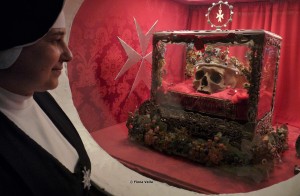 Wara li rriċerkajt din it-tema, ma stajtx ma nżurx il-post fejn tinsab din ir-relikwa. Akkost li l-monasteru jiġbor fih sorijiet tal-klawsura, it-talba tiegħi ġiet milqugħa mal-ewwel u ma domtx ma sibt ruħi wiċċ imb’wiċċ ma’ dan il-bniedem li tant nies jitkellmu b’rispett lejh.
Wara li rriċerkajt din it-tema, ma stajtx ma nżurx il-post fejn tinsab din ir-relikwa. Akkost li l-monasteru jiġbor fih sorijiet tal-klawsura, it-talba tiegħi ġiet milqugħa mal-ewwel u ma domtx ma sibt ruħi wiċċ imb’wiċċ ma’ dan il-bniedem li tant nies jitkellmu b’rispett lejh.“Kull sena, jiġu għadd ta’ nies minn madwar l-Ewropa kollha biex iżuru din ir-relikwa,” infurmatni l-Madre Prijoressa Sr. Agnese Zammit OSS tal-Monasteru ta’ Sant’Ursula l-Belt.
 “F’April li għadda, kellna anki żjara statali mill-Prinċep u Gran Mastru tal-Ordni ta’ San Ġwann ta’ Ġerusalemm, ta’ Rodi u ta’ Malta, Frá. Matthew Festing. Għal din l-okkażjoni, peress li aħna sorijiet tal-Ordni, nilbsu l-abitu statali li jinkludi l-istolone u l-manto di punta”.
“F’April li għadda, kellna anki żjara statali mill-Prinċep u Gran Mastru tal-Ordni ta’ San Ġwann ta’ Ġerusalemm, ta’ Rodi u ta’ Malta, Frá. Matthew Festing. Għal din l-okkażjoni, peress li aħna sorijiet tal-Ordni, nilbsu l-abitu statali li jinkludi l-istolone u l-manto di punta”.Kull sena, fit-13 t’Ottubru, dawn is-sorijiet jorganizzaw quddiesa solenni b’rispett lejn Patri Gerard. Għal din iċ-ċelebrazzjoni, jattendu l-Kavallieri ta’ San Ġwann kollha li joqogħdu Malta u mill-ġdid huma jilbsu l-abitu statali.
Ħadd ma jaf kien kien jidher wiċċu
Ħadd ma jaf fiċ-ċert kif kien wiċċ Patri Gerard. Madanakollu, sforz ir-rispett kbir li n-nies minn dejjem kellhom lejh, saru diversi pitturi tiegħu fejn wiċċu ġie mmaġinat mill-artisti. Wieħed minn dawn il-kwadri li juri lil Patri Gerard qed jilqa’ lil Godfrey de Bouillon, Duka ta’ Lower Lorraine u mexxej tal-Ewwel Kruċjata ġie maħdum mill-pittur magħruf Antoine De Favray u jinsab esebit fil-Mużew Nazzjonali tal-Arti fi Triq Nofsinhar il-Belt.
Sadanittant, jekk qanqaltilkhom biżżejjed kurżità, tistgħu taraw ukoll kopja ta’ dan il-kwadru fuq il-blog tal-Assedju l-Kbir ta’ Heritage Malta – www.heritagemalta.org/1565
Apparti kurżitajiet simili relatati mal-Ordni ta’ San Ġwann, f’dan il-blog tistgħu ssegwu wkoll rakkonti ġurnata b’ġurnata ta’ dak li għaddew minnu Malta, il-Maltin u l-Kavallieri waqt il-perjodu aħrax tal-Assedju l-Kbir li beda f’Mejju u ntemm f’Settembru tal-1565.
(Dan l-artiklu ġie ppubblikat fis-sensiela MINN RITRATT (12 il-parti) fit-Torċa tas-7 ta’ Ġunju 2015)
-
Fixing Time
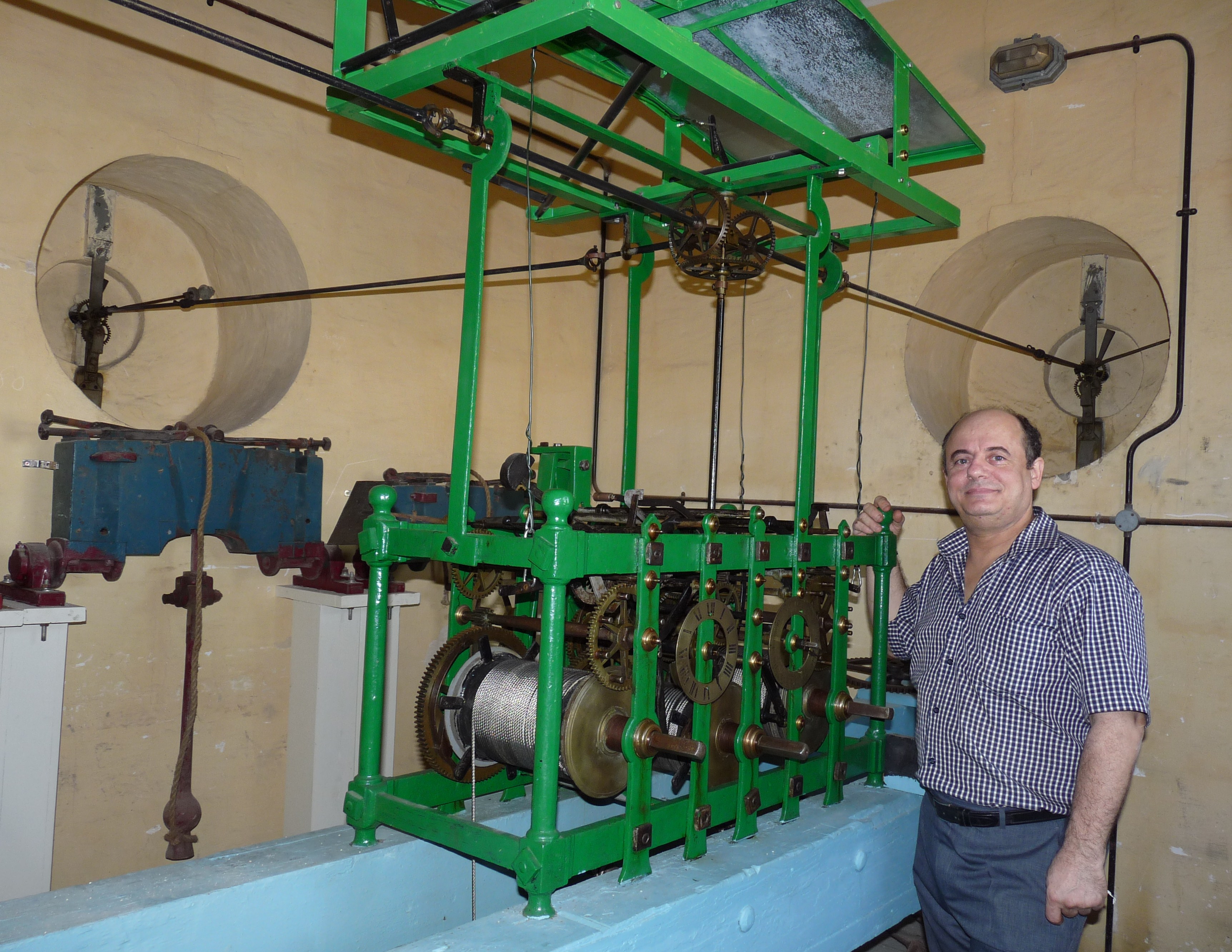
I met Stephen Zammit on the roof of the Malta Maritime Museum in order to watch closely the mechanism of the British 19th century clock which he has restored last year. This was certainly an exclusive moment since I was clearly warned that Zammit is very possessive of ‘his’ clocks.
In fact, there was a magnificent view of the Vittoriosa Marina but Zammit’s eyes and admiration were dedicated only to the imposing clock tower which was sheltering the elaborate clock’s mechanism within its walls.
“Originally this clock was located within a small steeple which overlooked dock number one,” he informed me. “After it was moved here, the dials of this clock face Cospicua, Senglea and Valletta. Apart from its mechanism, Heritage Malta restored also the dials of this clock according to how it looked originally in old pictures and paintings; that is with a black face and with gold numbers and dials. Isn’t it a beauty now?”
Zammit has always been fascinated by clocks. His first interest was sparked off by Ħ’Attard’s parish’s tower clock where he attended church as a small boy.
At only 11 years of age, he started to open the wind-up alarm clocks which they had at home in order to observe their components. Soon, he ventured to repair some of these clocks by noting what was out of place or what was broken.
“When I found a missing or a broken part, I used to go and order it from a clock spare-parts’ agent in Valletta,” he reminisced. “From him, I learnt and memorized the names of each item until eventually I got to know each section of a clock.”
Later on, he turned to watches which were much smaller and required more attention. It was his utter joy to hear an old watch ticking again after he sorted out its malfunctioning part.
He became involved in church clocks incidentally, when Rev. Can. Louis Suban, who was the parish priest of Msida, asked Zammit’s uncle whether he knew someone who could repair the 18th century parish clock.
“My uncle recommended me and Fr Suban contacted me. I was delighted to work on such an antique clock! When I went to see it, I noticed that the clock had severely deteriorated parts, both due to the natural elements and also because of wear and tear. After these were replaced, the clock came back to life and it is still working,” he said proudly.
“Fr. Suban has a keen interest in clocks since his ancestors used to produce clocks for churches including those of the parishes of Marsaxlokk and Ħal-Safi. Incidentally, they also made some repairs on this clock here,” Zammit said as he pulled out a key and let me in to see the mechanism’s structure.
He pointed at a section among the intricate metal configuration where there was the engraved signature – Brothers Suban. Malta. 1896.
“Generally, all clock makers and repairers leave an identifying mark in order to record their work,” he told me as he indicated another signature. “This inscription reveals who constructed this system, where and when – Matthew Dutton. London. 1810.”
By detecting these clues on several clocks, Zammit became aware of the various clock makers and repairers that we had in Malta along the centuries.
“I feel very disappointed when I hear people talking only about particular clock makers and ignore all the rest as if they never existed,” he proclaimed.
“For example, many know about Michelangelo Sapiano because he was one of the most prolific workers in the sector of clock making. Indeed, he was lucky enough to live in a time when there was a great demand for church clocks and he made the best of this opportunity.”
In fact, Sapiano was behind the construction of around 21 clocks of various parishes, including that of the parish of Ħal-Luqa.
“When I was called to repair Sapiano’s clock in Ħal-Luqa, I could clearly understand the genius of this man. I was enthralled to follow his thinking through his work and to notice how he maneuvered a system so that the mechanism’s structure regulated three different time dials and another one which showed the date.”
According to Zammit, Sapiano learnt this trade from the Tanti family who manufactured about seven local parish clocks, including those of Qrendi and Ħal-Tarxien. Yet somehow, clock enthusiasts who admire and talk much about Sapiano, seem to know nothing about his predecessors.
For more than thirty years, Zammit had the opportunity to work on several huge parish clocks and by time, he acquired an instinctive ability of how to recognize the various clock makers. Likewise, he became inherently skilled in repairing the different systems by getting acquainted to the standard form of the core of these structures and also to the evolving variables of each constructor.
Zammit used the clock in front of us in order to help me to understand how it functioned.
“As you can see, there are three sections,” he said. “The one in the middle is connected to a pendulum so that it could regulate the time. The other sections are the ones which moderate the quarters and the hours.”
All along our discussion, we were accompanied by the regular ticking of the clock. Yet, suddenly, a sudden twitch on one of the gear wheels seemed to awaken the whole mechanism as many more items of the metallic structure moved, rotated and flapped, whilst a lever pulled and pushed high up to the iron hammers and instilled them to bang on the bells in order to mark the time.
We both stood in reverent silence as the bells chimed gracefully and their melodious echo slipped in the small room.
“You would probably think that by now I have got used to this experience,” Zammit broke the silence, once the bells stopped ringing and the apparatus calmed down to its regular ticking. “However, as you can see, I am still completely bewitched by the spell of these compositions.”
Being also a violinist with the Malta Philharmonic Orchestra, he is naturally enraptured by the involvement of the musical tones which are operated by this system.
“I come to regulate this clock once a week,” Zammit informed me as he started to manipulate the three weights of the clock.
I stood back and observed as he made the necessary adjustments. From the mechanism’s obliging response, I seemed to sense an aura of a corresponding comradeship.
“Each time that I go to do some work on a clock, I just can’t resist the temptation to stay for another whole hour in order to confirm that everything is working well. There were even moments when people forgot that I was in the clock tower and locked me in the church,” he admitted as he chuckled warmly.
There was again an abrupt movement within the clock’s structure. Another quarter of an hour had passed and the system activated itself again. This time, I was not taken by surprise. Like Zammit, I was simply spellbound.
(This article was published in the Business of Time supplement that was issued with The Times of Malta dated 30th October 2014)
-
THE SICILIAN CONNECTION – Archaeotur Project
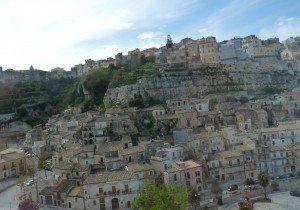 Though many Maltese tend to perceive their archipelago as a solitary group of islands in the centre of the Mediterranean Sea, the nearby island Sicily has always been closely present both geographically and often historically. The Archaeotur project aims to enhance the rediscovery of the archaeological and cultural identities of both islands, particularly by setting up a set of heritage trails which link a number of renowned sites together with other interesting locations that are presently found off the usual beaten tourist track.
Though many Maltese tend to perceive their archipelago as a solitary group of islands in the centre of the Mediterranean Sea, the nearby island Sicily has always been closely present both geographically and often historically. The Archaeotur project aims to enhance the rediscovery of the archaeological and cultural identities of both islands, particularly by setting up a set of heritage trails which link a number of renowned sites together with other interesting locations that are presently found off the usual beaten tourist track.On crisp clear nights, some Sicilians search out for Malta’s twinkling lights across the separating sea known as the channel of Malta. Similarly during a fine limpid day, the area of Mount Etna is distinctly visible from Mdina. One may thus wonder how the ancient populations of these islands might have regarded this ‘nearness’ and what they might have shared. The Archaeotur project focuses on these similarities but also on the differences which vividly portray an affinity but no less a diversity between the two places, thereby enticingly creating a new world to discover just a few kilometres away.
 During last April, a group of Maltese experts in archaeology and in cultural tourism, together with a number of local university students, attended a three-day seminar that was held at the Auditorium San Vincenzo Ferreri in Ragusa Ibla. The Maltese and Sicilian counterparts discussed the plans of the Archaeotur project, gave detailed descriptions of some of the concerned archaeological sites and the findings discovered within, and shared information and ideas about what has been done so far and what work still needs to be tackled so that these sites are conserved and presented in the most professional way to all the visitors.
During last April, a group of Maltese experts in archaeology and in cultural tourism, together with a number of local university students, attended a three-day seminar that was held at the Auditorium San Vincenzo Ferreri in Ragusa Ibla. The Maltese and Sicilian counterparts discussed the plans of the Archaeotur project, gave detailed descriptions of some of the concerned archaeological sites and the findings discovered within, and shared information and ideas about what has been done so far and what work still needs to be tackled so that these sites are conserved and presented in the most professional way to all the visitors. Residing in a small hotel in Ragusa Ibla, the Maltese participants could indulge in the historical aura of the oldest part of this town. Narrow alleys with speeding motorini and compact vans running through them led to some impressive medieval buildings and baroque palaces. Interestingly much of this area had to be rebuilt after a very strong earthquake hit Ragusa on the 11th January 1693, killing about 5000 people and destroying many remarkable buildings such as a castle, palaces, churches, and many houses. After this catastrophe, some survivors in Ragusa wanted to rebuild the destroyed part of the town in the same place whilst others preferred to build their residences in another area, thereby creating two facets of this town which eventually became known as the old and the modern Ragusa. Three bridges which connect the older part to the new part of the town have inspired people to identify Ragusa as the city of bridges. These bridges provide a stunning view of this historical town, its buildings huddled closely together, as if clinging for life to the strong high precipice. In the last years, the old centre has been revived again with the opening of a number of shops, bars, restaurants and hotels. Indeed, Ragusa’s distinguished Sicilian character has attracted many photographers and film producers, the latest of which being the popular Italian TV series of ‘Il Commissario Montalbano’.
Residing in a small hotel in Ragusa Ibla, the Maltese participants could indulge in the historical aura of the oldest part of this town. Narrow alleys with speeding motorini and compact vans running through them led to some impressive medieval buildings and baroque palaces. Interestingly much of this area had to be rebuilt after a very strong earthquake hit Ragusa on the 11th January 1693, killing about 5000 people and destroying many remarkable buildings such as a castle, palaces, churches, and many houses. After this catastrophe, some survivors in Ragusa wanted to rebuild the destroyed part of the town in the same place whilst others preferred to build their residences in another area, thereby creating two facets of this town which eventually became known as the old and the modern Ragusa. Three bridges which connect the older part to the new part of the town have inspired people to identify Ragusa as the city of bridges. These bridges provide a stunning view of this historical town, its buildings huddled closely together, as if clinging for life to the strong high precipice. In the last years, the old centre has been revived again with the opening of a number of shops, bars, restaurants and hotels. Indeed, Ragusa’s distinguished Sicilian character has attracted many photographers and film producers, the latest of which being the popular Italian TV series of ‘Il Commissario Montalbano’.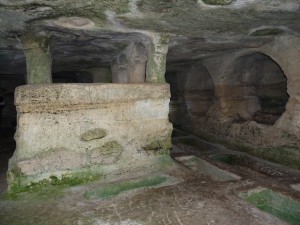 The seminars’ participants were also given the opportunity to visit some of the locations that are included in the Archaeotur project in order to understand better the significance and value of this endeavor. One of the most outstanding was certainly the catacomb of the Grotta delle Trabacche in Ragusa. Recently, this catacomb has been thoroughly cleaned out and conserved, and information posts have been placed in the vicinity in order to guide those visiting this site. Two central opulent and monumental tombs within this catacomb indicate that two individuals who had some importance or a form of authority in their society were buried there. Moreover, one finds several other common tombs that were dug out of the walls and floors of the cavern.
The seminars’ participants were also given the opportunity to visit some of the locations that are included in the Archaeotur project in order to understand better the significance and value of this endeavor. One of the most outstanding was certainly the catacomb of the Grotta delle Trabacche in Ragusa. Recently, this catacomb has been thoroughly cleaned out and conserved, and information posts have been placed in the vicinity in order to guide those visiting this site. Two central opulent and monumental tombs within this catacomb indicate that two individuals who had some importance or a form of authority in their society were buried there. Moreover, one finds several other common tombs that were dug out of the walls and floors of the cavern.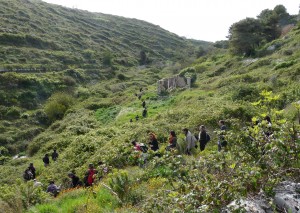 Ironically although hypogea and catacombs are directly connected with death, these sites tend also to provide crucial information about the life and the rituals of the living individuals who used these places. Therefore for example, a multitude of catacombs that are present in Cava Celone might be expressing the situation of an increasing population. These archaeological sites are magnificently enfolded within a wide valley full of wild vegetation, thus endowing the experience of visiting them with a sense of adventure; the silence reigning within the valley allows one to feel truly at one with nature. Meanwhile, the visit to three catacombs in this location revealed the work that still needs to be done on these archaeological sites, including cleaning, conserving, and planning a more practical path which the visitors could use for easy access.
Ironically although hypogea and catacombs are directly connected with death, these sites tend also to provide crucial information about the life and the rituals of the living individuals who used these places. Therefore for example, a multitude of catacombs that are present in Cava Celone might be expressing the situation of an increasing population. These archaeological sites are magnificently enfolded within a wide valley full of wild vegetation, thus endowing the experience of visiting them with a sense of adventure; the silence reigning within the valley allows one to feel truly at one with nature. Meanwhile, the visit to three catacombs in this location revealed the work that still needs to be done on these archaeological sites, including cleaning, conserving, and planning a more practical path which the visitors could use for easy access.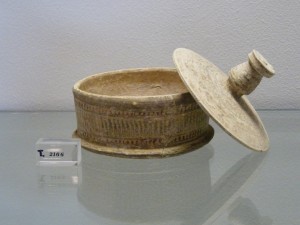 A visit to the Regional Museum of Camarina was undoubtedly distinctive especially because of the extraordinary display of a multitude of findings that were discovered both on land and under the sea of the Santa Croce Camarina area. Many of the artefacts discovered on land pertain to burial rites. Some of them are so refined that it is believed that they belonged to a Greek aristocracy who had immigrated to this area. On the other hand, the numerous objects that were recovered from several wrecks in the bay of Camarina demonstrate that many commercial ships passed through this zone. Among the prestigious exhibits, one finds a bronze archaic helmet that was recovered from a relic that lay seven metres under the sea in front of Punta Braccetto. Several amphorae, a classical Attic-Etruscan helmet, seventy-three clay lamps and some silver items were retrieved from two other relics that were buried in the middle of the bay. Likewise, in 1991, a huge storm revealed the treasure trove of a hoard of 6000 coins that was buried only 200 metres away from the coast.
A visit to the Regional Museum of Camarina was undoubtedly distinctive especially because of the extraordinary display of a multitude of findings that were discovered both on land and under the sea of the Santa Croce Camarina area. Many of the artefacts discovered on land pertain to burial rites. Some of them are so refined that it is believed that they belonged to a Greek aristocracy who had immigrated to this area. On the other hand, the numerous objects that were recovered from several wrecks in the bay of Camarina demonstrate that many commercial ships passed through this zone. Among the prestigious exhibits, one finds a bronze archaic helmet that was recovered from a relic that lay seven metres under the sea in front of Punta Braccetto. Several amphorae, a classical Attic-Etruscan helmet, seventy-three clay lamps and some silver items were retrieved from two other relics that were buried in the middle of the bay. Likewise, in 1991, a huge storm revealed the treasure trove of a hoard of 6000 coins that was buried only 200 metres away from the coast.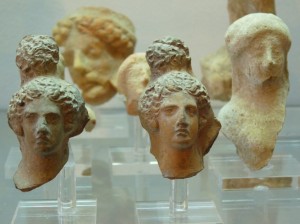 Undeniably, the participants in this seminar had a good taste of the potential of these Sicilian sites that are included in the project of Archaeotur. In the first week of September, a second seminar, this time organized in Malta, will once again reunite Maltese and Sicilian experts and participants so that they can evaluate the work that has been done so far and also to visit some of the Maltese sites which form part of the Archaeotur project.
Undeniably, the participants in this seminar had a good taste of the potential of these Sicilian sites that are included in the project of Archaeotur. In the first week of September, a second seminar, this time organized in Malta, will once again reunite Maltese and Sicilian experts and participants so that they can evaluate the work that has been done so far and also to visit some of the Maltese sites which form part of the Archaeotur project.No doubt this EU project is proving of great benefit towards cross-border cooperation in the sector of heritage conservation and interpretation and no less to cultural tourism which is certainly of substantial benefit to both territories.
Archaeotur is a 1.37 million euro project which is co-financed under the Italia-Malta Programme Cohesion Policy 2007 – 2013 and is part-financed by the EU European Regional Development Fund. The partners involved within it are: Mosta and Rabat Local Councils, Heritage Malta, Malta Tourism Authority, the Comune of Ragusa and the Comune of Santa Croce Camarina, the Superintendence of BB.CC.AA Ragusa, the Archaeological Park of Camarina, and Giritravel SRL. The main purpose of this project is to conserve, interpret and market a number of archaeological sites which generally consist of hypogea and catacombs across the Maltese and Italian borders such as: Ta’ Bistra (Mosta), St Augustine (Rabat), Trabacche, Cava Celone, Cisternazzi and Donnafugata (Ragusa), and Mezzagnone, Pirrera and Mirio (Santa Croce Camarina).
Further information about the Archaeotur project may be obtained through the website www.archaeotur.eu or by contacting Archaeotur Curator, Glen Farrugia, on glen.farrugia@gov.mt
(Note: An edited version of this article was published on FIRST magazine Issue September 2012).
-
ARCHAEOTUR: PROĠETT LI JGĦAQQAD SITI KULTURALI F’MALTA U F’RAGUSA
 Bejn il-5 u s-7 ta’ Settembru 2012, fis-Sala Sant’Anġlu ġewwa l-Mużew Marittimu tal-Birgu, ser tiġi organizzata t-tieni parti ta’ seminar konness mal-proġett Archaeotur. Dawn il-laqgħat għandhom jinteressaw lil dawk kollha li għandhom għal qalbhom il-wirt kulturali nazzjonali u kif ukoll dak dinji. Għalkemm il-parteċipazzjoni f’dawn is-seminars hija b’xejn, huwa rakkommandat illi wieħed jirreġistra sabiex jirriserva post.
Bejn il-5 u s-7 ta’ Settembru 2012, fis-Sala Sant’Anġlu ġewwa l-Mużew Marittimu tal-Birgu, ser tiġi organizzata t-tieni parti ta’ seminar konness mal-proġett Archaeotur. Dawn il-laqgħat għandhom jinteressaw lil dawk kollha li għandhom għal qalbhom il-wirt kulturali nazzjonali u kif ukoll dak dinji. Għalkemm il-parteċipazzjoni f’dawn is-seminars hija b’xejn, huwa rakkommandat illi wieħed jirreġistra sabiex jirriserva post.Bejn is-sittax u t-tmintax-il seklu l-Grand Tour kien avventura popolari ħafna mal-familji aristokratiċi Ewropej. Infatti, bosta minnhom kienu jibagħtu lill-iben il-kbir tal-familja għall-vjaġġ ta’ sena madwar l-Ewropa sabiex hemm iżur is-siti klassiċi tal-arkeoloġija u b’hekk jifforma aħjar il-lat edukattiv u kulturali tiegħu. Uħud minn dawn kienu saħansitra jaslu sa Malta u fil-fatt fis-seklu sbatax insibu lil Ġan Franġisk Abela jakkompanja lill-viżitaturi ġewwa l-katakombi ta’ San Pawl. Għad illi għaddew bosta snin, il-ġibda għat-turiżmu kulturali għadha ħajja sewwa, tant li llum dan sar niċċa importanti fl-industrija turistika kemm Maltija u kif ukoll Ewropeja. Dan ifisser li hemm bżonn dejjem iżjed li ninvestu fil-partimonju kulturali u storiku sabiex nirrenduh aktar magħruf u miftuħ għall-pubbliku interessat.
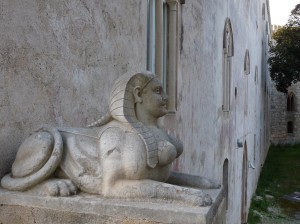 Il-proġett Archaeotur li ser jiswa 1.37 miljun ewro huwa kofinanzjat taħt il-Programm Italia-Malta, Cohesion Policy 2007–2013, u parzjalment iffinanzjat mill-Fond Ewropew tal-Iżvilupp Reġjonali. Fih hemm involuti il-Kunsill Lokali tal-Mosta u dak tar-Rabat (Malta), Heritage Malta, l-Awtorità Maltija għat-Turiżmu, il-Comune di Ragusa u l-Comune di Santa Croce Camarina, is-Superintendenza dei BB.CC.AA di Ragusa f’kollaborazzjoni mal-Parco Archaeologico di Camarina u Giritravel SRL. L-għan aħħari tal-proġett Archaeotur huwa l-konservazzjoni u l-promozzjoni ta’ numru ta’ siti arkeoloġiċi li bosta minnhom jikkonsistu f’ipoġej jew katakombi f’Malta u fi Sqallija: Ta’ Bistra (il-Mosta) u Santu Wistin (ir-Rabat), Trabacche, Cava Celone, Cisternazzi u Donnafugata (Ragusa), u Mezzagnone, Pirrera u Mirio (Santa Croce Camarina).
Il-proġett Archaeotur li ser jiswa 1.37 miljun ewro huwa kofinanzjat taħt il-Programm Italia-Malta, Cohesion Policy 2007–2013, u parzjalment iffinanzjat mill-Fond Ewropew tal-Iżvilupp Reġjonali. Fih hemm involuti il-Kunsill Lokali tal-Mosta u dak tar-Rabat (Malta), Heritage Malta, l-Awtorità Maltija għat-Turiżmu, il-Comune di Ragusa u l-Comune di Santa Croce Camarina, is-Superintendenza dei BB.CC.AA di Ragusa f’kollaborazzjoni mal-Parco Archaeologico di Camarina u Giritravel SRL. L-għan aħħari tal-proġett Archaeotur huwa l-konservazzjoni u l-promozzjoni ta’ numru ta’ siti arkeoloġiċi li bosta minnhom jikkonsistu f’ipoġej jew katakombi f’Malta u fi Sqallija: Ta’ Bistra (il-Mosta) u Santu Wistin (ir-Rabat), Trabacche, Cava Celone, Cisternazzi u Donnafugata (Ragusa), u Mezzagnone, Pirrera u Mirio (Santa Croce Camarina).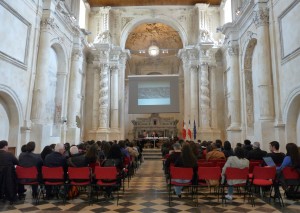 L-ewwel parti ta’ dawn is-seminars saret bejn il-11 u t-13 t’April 2012 ġewwa l-Auditorium San Vincenzo Ferreri f’Ragusa Ibla. Numru ta’ esperti f’dan il-qasam, kemm minn Malta u kif ukoll minn Sqallija, ddiskutew il-pjanijiet u l-miri tal-proġett Archaeotur, taw deskrizzjoni dettaljata ta’ xi siti u sejbiet arkeoloġiċi, u qasmu bejniethom ideat dwar ix-xogħol li qed isir u dak li għad irid jitwettaq sabiex dawn il-postijiet jiġu kkonservati u ppreżenati lill-viżitaturi bl-aktar mod professjonali.
L-ewwel parti ta’ dawn is-seminars saret bejn il-11 u t-13 t’April 2012 ġewwa l-Auditorium San Vincenzo Ferreri f’Ragusa Ibla. Numru ta’ esperti f’dan il-qasam, kemm minn Malta u kif ukoll minn Sqallija, ddiskutew il-pjanijiet u l-miri tal-proġett Archaeotur, taw deskrizzjoni dettaljata ta’ xi siti u sejbiet arkeoloġiċi, u qasmu bejniethom ideat dwar ix-xogħol li qed isir u dak li għad irid jitwettaq sabiex dawn il-postijiet jiġu kkonservati u ppreżenati lill-viżitaturi bl-aktar mod professjonali. Għal dawn is-seminars attendew ukoll numru ta’ studenti universitarji kemm Maltin u kif ukoll Sqallin, li flimkien mal-kelliema kellhom ukoll l-opportunità li jżuru wħud minn dawn is-siti sabiex b’hekk jifhmu aħjar is-sinifikat tal-proġett Archaeotur. Ngħidu aħna fil-Grotta delle Trabacche f’Ragusa kien evidenti x-xogħol ta’ tindif u konservazzjoni li kien sar fil-post fejn anki tpoġġew tabelli b’tagħrif għall-viżitaturi. Dan il-katakombi huwa meqjus bħala wieħed mis-siti l-aktar sinifikanti, l-aktar minħabba l-grandjożità monumentali ta’ żewġ oqbra li jinsabu fiċ-ċentru tiegħu, mdawwrin b’oqbra aktar sempliċi mħaffra fil-ħitan u fl-art tal-għar. Indubbjament dawn jagħtu indikazzjoni li almenu żewġ individwi ta’ ċerta importanza jew awtorità fis-soċjetà tal-madwar indifnu hemm.
Għal dawn is-seminars attendew ukoll numru ta’ studenti universitarji kemm Maltin u kif ukoll Sqallin, li flimkien mal-kelliema kellhom ukoll l-opportunità li jżuru wħud minn dawn is-siti sabiex b’hekk jifhmu aħjar is-sinifikat tal-proġett Archaeotur. Ngħidu aħna fil-Grotta delle Trabacche f’Ragusa kien evidenti x-xogħol ta’ tindif u konservazzjoni li kien sar fil-post fejn anki tpoġġew tabelli b’tagħrif għall-viżitaturi. Dan il-katakombi huwa meqjus bħala wieħed mis-siti l-aktar sinifikanti, l-aktar minħabba l-grandjożità monumentali ta’ żewġ oqbra li jinsabu fiċ-ċentru tiegħu, mdawwrin b’oqbra aktar sempliċi mħaffra fil-ħitan u fl-art tal-għar. Indubbjament dawn jagħtu indikazzjoni li almenu żewġ individwi ta’ ċerta importanza jew awtorità fis-soċjetà tal-madwar indifnu hemm.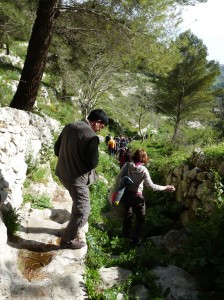 Ironikament, dawn il-postijiet konnessi mal-mewt għandhom ħabta jservu bħala fonti kruċjali ta’ informazzjoni dwar il-ħajja u l-użanzi tan-nies li sawwruhom u użawhom għall-bżonnijiet u r-ritwali tagħhom. Għalhekk, il-kwantità ta’ katakombi li wieħed isib f’Cava Celone, jista’ jkun li qed tirrappreżenta żieda sostanzjali fil-popolazzjoni ta’ dak iż-żmien. Iż-żjara fi tliet katakombi maġġuri wriet li f’dawn il-postijiet kien għad fadal ħafna xogħol xi jsir, speċjalment biex jitfasslu sinjali, mogħdijiet u trejqat aktar adegwati ħalli dawn il-postijiet jintlaħqu aktar faċilment mill-viżitaturi. Wieħed ma jistax ma jsemmix li dawn l-inħawi jinsabu f’wied mill-isbaħ, mogħni b’natura mhux mittiefsa fejn b’hekk il-viżitatur jista’ jitpaxxa bil-ġmiel tal-post filwaqt li jgawdi mis-sens tal-avventura li toffri kull esplorazzjoni.
Ironikament, dawn il-postijiet konnessi mal-mewt għandhom ħabta jservu bħala fonti kruċjali ta’ informazzjoni dwar il-ħajja u l-użanzi tan-nies li sawwruhom u użawhom għall-bżonnijiet u r-ritwali tagħhom. Għalhekk, il-kwantità ta’ katakombi li wieħed isib f’Cava Celone, jista’ jkun li qed tirrappreżenta żieda sostanzjali fil-popolazzjoni ta’ dak iż-żmien. Iż-żjara fi tliet katakombi maġġuri wriet li f’dawn il-postijiet kien għad fadal ħafna xogħol xi jsir, speċjalment biex jitfasslu sinjali, mogħdijiet u trejqat aktar adegwati ħalli dawn il-postijiet jintlaħqu aktar faċilment mill-viżitaturi. Wieħed ma jistax ma jsemmix li dawn l-inħawi jinsabu f’wied mill-isbaħ, mogħni b’natura mhux mittiefsa fejn b’hekk il-viżitatur jista’ jitpaxxa bil-ġmiel tal-post filwaqt li jgawdi mis-sens tal-avventura li toffri kull esplorazzjoni.Infatti l-proġett Archaeotur huwa ffukat fuq it-tisħiħ tal-valur tal-esperjenza tat-turiżmu kulturali fejn it-turist ikun jista’ jżur għażla ta’ siti ta’ interess permezz ta’ heritage trails li jgħaqqdu f’itinerarju wieħed numru ta’ siti li forsi s’issa ma kinux qed jingħataw daqshekk importanza. Ngħidu aħna bosta turisti li jżuru l-kastell ta’ Donnafugata f’Ragusa probabbilment ma jafux li tefgħa ta’ ġebla ’l bogħod, mogħdija dejqa mistura fil-ħdura ta’ natura mill-iprem, twassal għal katakombi ċkejken li jmur lura għar-raba’ jew il-ħames seklu W.K.
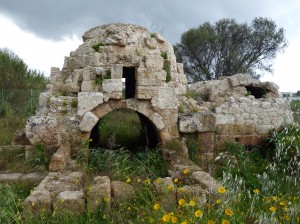 L-istess nistgħu ngħidu għall-fdalijiet arkeoloġiċi mhux tas-soltu li jinsabu f’nofs ta’ għalqa ġewwa Mezzagnone f’Santa Croce Camarina. Din il-binja, li ilha tqanqal l-kurżità tal-istudjużi sa minn żmien twil, hija maħsuba li tmur lura għal bejn ir-raba’ u d-disgħa seklu W.K. u li għal xi żmien intużat bħala banju termali. Inċidentalment, dawk li jżuru dan il-post jistgħu jkomplu triqithom ftit kilometri oħra sabiex japprezzaw il-kollezzjoni arkeoloġika vasta li tinsab fil-Mużew Reġjonali ta’ Camarina. Imfittex minn bosta studjużi, partikolarment minħabba l-għadd kbir ta’ anfori ta’ tipi differenti li jħaddan fih, dan il-Mużew huwa mogħni b’sejbiet sinifikanti li nstabu fl-inħawi kemm taħt l-art u kif ukoll taħt il-baħar. Bosta mill-oġġetti li ġew skavati mill-art huma konnessi mar-ritwali tad-dfin, uħud minnhom tant huma raffinati u prestiġġjużi, li huwa maħsub li kienu jappartjenu lill-ewwel immigranti aristokratiċi Griegi li marru joqogħdu
L-istess nistgħu ngħidu għall-fdalijiet arkeoloġiċi mhux tas-soltu li jinsabu f’nofs ta’ għalqa ġewwa Mezzagnone f’Santa Croce Camarina. Din il-binja, li ilha tqanqal l-kurżità tal-istudjużi sa minn żmien twil, hija maħsuba li tmur lura għal bejn ir-raba’ u d-disgħa seklu W.K. u li għal xi żmien intużat bħala banju termali. Inċidentalment, dawk li jżuru dan il-post jistgħu jkomplu triqithom ftit kilometri oħra sabiex japprezzaw il-kollezzjoni arkeoloġika vasta li tinsab fil-Mużew Reġjonali ta’ Camarina. Imfittex minn bosta studjużi, partikolarment minħabba l-għadd kbir ta’ anfori ta’ tipi differenti li jħaddan fih, dan il-Mużew huwa mogħni b’sejbiet sinifikanti li nstabu fl-inħawi kemm taħt l-art u kif ukoll taħt il-baħar. Bosta mill-oġġetti li ġew skavati mill-art huma konnessi mar-ritwali tad-dfin, uħud minnhom tant huma raffinati u prestiġġjużi, li huwa maħsub li kienu jappartjenu lill-ewwel immigranti aristokratiċi Griegi li marru joqogħdu 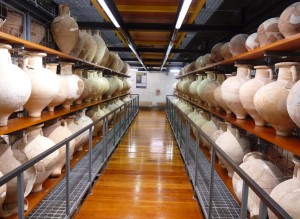 f’dawk l-inħawi. Affarijiet oħra li ttellgħu mill-bajja ta’ Camarina kienu jiffurmaw parti mit-tagħbija kummerċjali ta’ bosta xwieni li għerqu fil-post: prova tal-kummerċ kbir li kien isir f’dawk l-inħawi f’perjodi mbiegħda. Dawk l-aktar spettakolari jinkludu żewġ elmi tal-gwerra, numru ta’ statwetti u għodod, u kwantità ta’ msiebaħ u oġġetti tal-fidda.Huwa fatt magħruf li din il-bajja ta’ Camarina dan l-aħħar saret famuża mat-turisti minħabba s-serje popolari televiżiva ‘Il Commissario Montalbano’ peress li diversi xeni nġibdu f’dawn l-inħawi. Min-naħa l-oħra aktarx ftit jafu li f’din il-bajja jinstabu regolarment oġġetti arkeoloġiċi – bħas-6000 munita antika li nqalgħu minn taħt ir-ramel wara tempesta qalila li seħħet fl-1991.
f’dawk l-inħawi. Affarijiet oħra li ttellgħu mill-bajja ta’ Camarina kienu jiffurmaw parti mit-tagħbija kummerċjali ta’ bosta xwieni li għerqu fil-post: prova tal-kummerċ kbir li kien isir f’dawk l-inħawi f’perjodi mbiegħda. Dawk l-aktar spettakolari jinkludu żewġ elmi tal-gwerra, numru ta’ statwetti u għodod, u kwantità ta’ msiebaħ u oġġetti tal-fidda.Huwa fatt magħruf li din il-bajja ta’ Camarina dan l-aħħar saret famuża mat-turisti minħabba s-serje popolari televiżiva ‘Il Commissario Montalbano’ peress li diversi xeni nġibdu f’dawn l-inħawi. Min-naħa l-oħra aktarx ftit jafu li f’din il-bajja jinstabu regolarment oġġetti arkeoloġiċi – bħas-6000 munita antika li nqalgħu minn taħt ir-ramel wara tempesta qalila li seħħet fl-1991.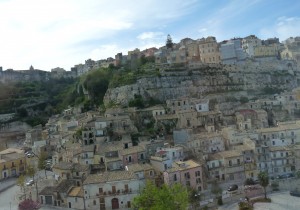 Il-parteċipanti Maltin kienu joqogħdu f’lukanda żgħira ġewwa Ragusa Ibla u minħabba f’hekk huma setgħu jirrikonoxxu kemm dan il-post huwa ideali biex wieħed iqatta’ erbat ijiem hawnhekk sabiex iżur dawn is-siti tal-madwar li tkellimna dwarhom. Ragusa Ibla nnifisha hija belt bi storja kbira. Xhieda ta’ dan huma d-diversi binjiet medjevali u palazzi barokki. Interessanti li wieħed isemmi li ħafna minn dawn il-binjiet kellhom jerġgħu jinbnew wara li parti kbira minn din il-belt ġiet meqruda minn terremot qawwi li seħħ fil-11 ta’ Jannar 1693, fejn anki mietu madwar 5000 persuna. Wara din id-diżgrazzja wħud mill-abitanti riedu jerġgħu jibnu l-belt fejn kienet oriġinarjament, filwaqt li oħrajn għażlu nħawi aktar fl-għoli biex jibnu r-residenza tagħhom. Infatti llum tliet pontijiet jgħaqqdu l-parti tal-belt l-antika mal-parti l-ġdida. Ragusa Ibla, bil-bini tagħha antik donnu mdendel mal-blat tal-irdumijiet u mgezzez f’xulxin, joffri dehra tassew spettakolari. Mhux ta’ b’xejn li l-post ġibed lejh bosta fotografi u anki kumpaniji tal-films.
Il-parteċipanti Maltin kienu joqogħdu f’lukanda żgħira ġewwa Ragusa Ibla u minħabba f’hekk huma setgħu jirrikonoxxu kemm dan il-post huwa ideali biex wieħed iqatta’ erbat ijiem hawnhekk sabiex iżur dawn is-siti tal-madwar li tkellimna dwarhom. Ragusa Ibla nnifisha hija belt bi storja kbira. Xhieda ta’ dan huma d-diversi binjiet medjevali u palazzi barokki. Interessanti li wieħed isemmi li ħafna minn dawn il-binjiet kellhom jerġgħu jinbnew wara li parti kbira minn din il-belt ġiet meqruda minn terremot qawwi li seħħ fil-11 ta’ Jannar 1693, fejn anki mietu madwar 5000 persuna. Wara din id-diżgrazzja wħud mill-abitanti riedu jerġgħu jibnu l-belt fejn kienet oriġinarjament, filwaqt li oħrajn għażlu nħawi aktar fl-għoli biex jibnu r-residenza tagħhom. Infatti llum tliet pontijiet jgħaqqdu l-parti tal-belt l-antika mal-parti l-ġdida. Ragusa Ibla, bil-bini tagħha antik donnu mdendel mal-blat tal-irdumijiet u mgezzez f’xulxin, joffri dehra tassew spettakolari. Mhux ta’ b’xejn li l-post ġibed lejh bosta fotografi u anki kumpaniji tal-films.Il-proġett Archaeotur huwa mistenni li jħeġġeġ aktar turiżmu kulturali bejn Ragusa u Malta, fosthom billi jinforma lill-pubbliku bl-opportunità li wieħed iżur dawn is-siti fiż-żewġ gżejjer. L-istorja ta’ Sqallija u ta’ Malta sikwit twaħħdet u mhux darba u tnejn li dawn il-popli, għalkemm mifrudin b’firxa wiesgħa ta’ baħar, għexu esperjenzi konnessi ma’ ta’ xulxin.
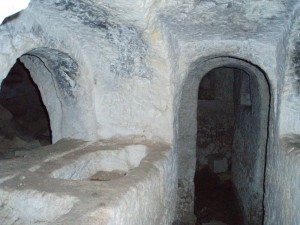 Għas-seminars ta’ Archaeotur li ser jiġu organizzati f’Malta, ser jattendu wkoll diversi esperti, studenti u individwi minn Sqallija ħalli b’hekk terġa’ tingħata l-opportunità għat-taħlit tal-ideat u għad-diskussjoni dwar ix-xogħol li għad fadal isir kemm fis-siti ta’ Malta u kif ukoll dawk ta’ Sqallija, sabiex b’hekk jistagħna l-patrimonju kulturali taż-żewġ gżejjer. Fuq kollox il-parteċipanti ser ikunu qed jiġu mdawwra ma’ xi siti arkeoloġiċi Maltin bħall-katakombi Ta’ Bistra fil-Mosta u dak ta’ Santu Wistin fir-Rabat, li s’issa qatt ma kienu miftuħa għall-pubbliku.
Għas-seminars ta’ Archaeotur li ser jiġu organizzati f’Malta, ser jattendu wkoll diversi esperti, studenti u individwi minn Sqallija ħalli b’hekk terġa’ tingħata l-opportunità għat-taħlit tal-ideat u għad-diskussjoni dwar ix-xogħol li għad fadal isir kemm fis-siti ta’ Malta u kif ukoll dawk ta’ Sqallija, sabiex b’hekk jistagħna l-patrimonju kulturali taż-żewġ gżejjer. Fuq kollox il-parteċipanti ser ikunu qed jiġu mdawwra ma’ xi siti arkeoloġiċi Maltin bħall-katakombi Ta’ Bistra fil-Mosta u dak ta’ Santu Wistin fir-Rabat, li s’issa qatt ma kienu miftuħa għall-pubbliku.Aktar informazzjoni dwar il-proġett Archaeotur tista’ tinkiseb mill-website www.archaeotur.eu. Reġistrazzjonijiet għall-attendenza f’dan is-seminar jistgħu jsiru kemm permezz tal-istess sit elettroniku, inkella billi tintbagħat e-mail lill-Kuratur tal-Proġett, Glen Farrugia, fuq glen.farrugia@gov.mt
(Nota: Dan l-artiklu ġie ppubblikat fit-Torċa tas-26 t’Awwissu 2012)
Travelogue
Archives
| M | T | W | T | F | S | S |
|---|---|---|---|---|---|---|
| « Jan | ||||||
| 1 | 2 | 3 | 4 | 5 | 6 | 7 |
| 8 | 9 | 10 | 11 | 12 | 13 | 14 |
| 15 | 16 | 17 | 18 | 19 | 20 | 21 |
| 22 | 23 | 24 | 25 | 26 | 27 | 28 |
| 29 | 30 | |||||
Recent Posts
- A MATTER OF FATE
- MALTA’S PREHISTORIC TREASURES
- THE MAGIC IS IN THE DETAIL
- THE SELLING GAME
- NEVER FORGOTTEN
- Ġrajjiet mhux mitmuma – 35 sena mit-Traġedja tal-Patrol Boat C23
- AN UNEXPECTED VISIT
- THE SISTERS OF THE CRIB
Comments
- Pauline Harkins on Novella – Li kieku stajt!
- admin on IL-KARNIVAL TRAĠIKU TAL-1823
- Albert on IL-KARNIVAL TRAĠIKU TAL-1823
- Martin Ratcliffe on Love in the time of war
- admin on 24 SENA ILU: IT-TRAĠEDJA TAL-PATROL BOAT C23